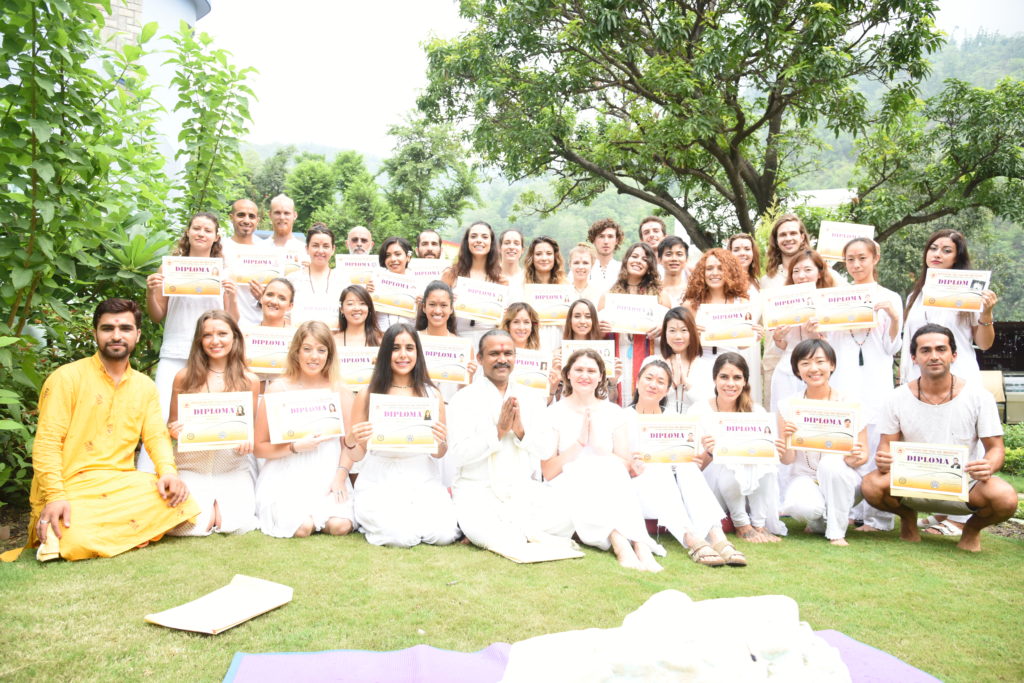
AYM YOGA SCHOOL REVIEW
200 Hour Yoga Teacher Training Course
Are you planning on travelling to Rishikesh for your 200 yoga teacher training course? Here is my detailed review of the AYM 200 hour yoga teacher training course in Rishikesh.
In June 2018 I attended my first 200-hour yoga teacher training course at AYM Yoga School, also known as Association for Yoga and Meditation and Indian Yoga Association, which is located in Upper Tapovan, Rishikesh. If you are anything like me you’re probably scrawling the internet trying to decide on which is the best school to attend. I spent HOURS researching different school in detail to try and decide.
Rishikesh is like a Disneyland now for Yoga schools. There are literally hundreds of schools each with a similar website, prices and offerings.
The reviews posted by previous students are usually pretty generic and positive without much detail as to what the school is actually like and miss out key information that you should know.
I’m writing this review to give you all the facts about the AYM yoga teacher training course in Rishikesh school so you know exactly what you are going to get!
Why I chose AYM in Rishikesh to complete my yoga teaching training course
I ended up selecting the AYM yoga teacher training course in Rishikesh for a view different reasons so here they are:
- It is an established school that has been around for a long time
- AYM has numerous positive reviews on all different platforms like bookyogaretreats.com, Google, Facebook & on the Yoga Alliance website.
- The school itself looked nicer in pictures than others with a big yoga hall with lots of windows and a garden to hang out in.
- The price seemed standard compared to the other schools I found online.
- The dates worked for me and my travels. The batches at AYM start mid-month as opposed to the beginning of the month like most other schools in Rishikesh
- I received recommendations for AYM on a yoga teacher Facebook group.
- They offered mixed style training in traditional Hatha and Ashtanga
- They said that class sizes are limited to 20 people (this is a half-truth!! Keep reading to find out what I mean)
Price and duration
The cost of the AYM 200-hour yoga teacher training in Rishikesh is $1350 for a shared room with one other person and $1500 for a private room. The training lasted for 27 days. It costs an additional $100 to have a room with AC. All prices are in USD.
Depending on the time of year and how you handle the heat it may be worth forking out for the aircon. I went in June which is basically the hottest month of the year so without aircon, it can be hard to sleep especially when there are power cuts during the night which mean your fan turns off!
On a side note if you are planning to attend in the winter months of November to February it gets freezing cold at night and it is highly unlikely you will have a heater, so keep that in mind when packing!
Fee inclusions
Here is a list of what was actually included in the course fees.
Course materials
- A bag and a t-shirt for the opening ceremony (hideous yellow thing!)
- Neti pot & sutra neti string (the rope kind not the rubber kind FYI)
- Coursebook which covered all the curriculum from classes and lectures
- This book called Asana Pranayama Mudra Bandha, which basically every school gives their students
- Notebook. I can’t remember if they gave us pens.
Excursions
Sunday is the only day off each week. We were exhausted on Sundays so spent a lot of time chilling in cafes and shopping in Laxman Jhula. We also managed to get to Ganga Aarti, which is a daily ritual at Parmarth Niketan Ashram to the Ganga River. One Sunday we had an organised excursion and another day we had a special activity planned for us, see below!
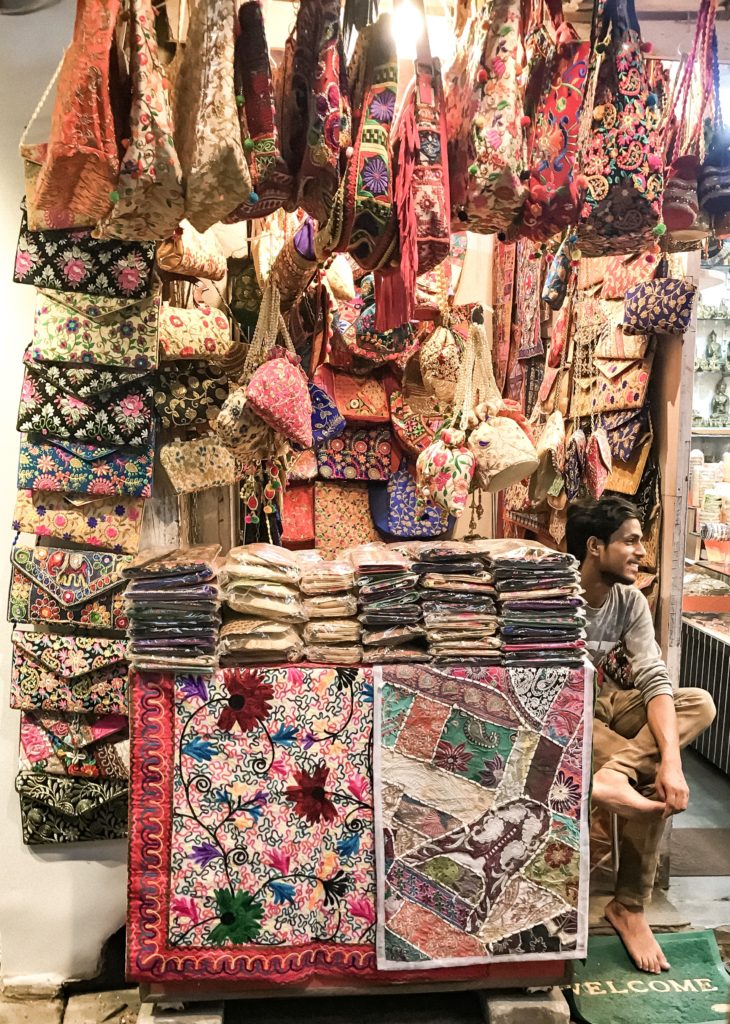
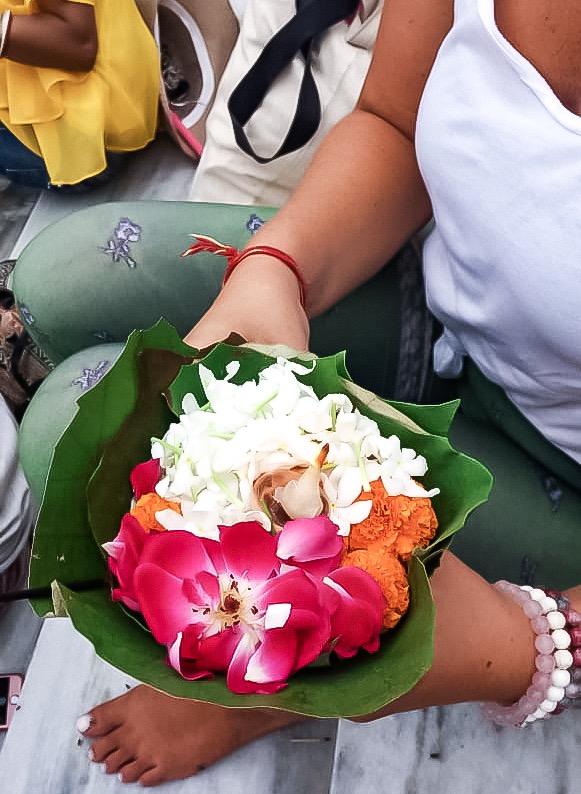
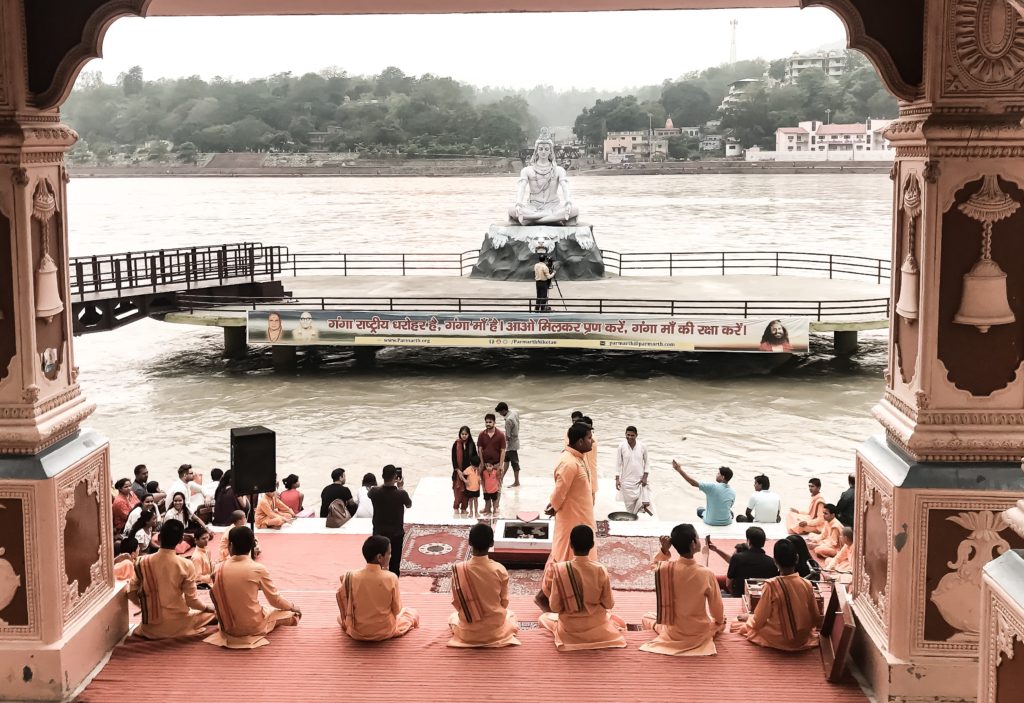

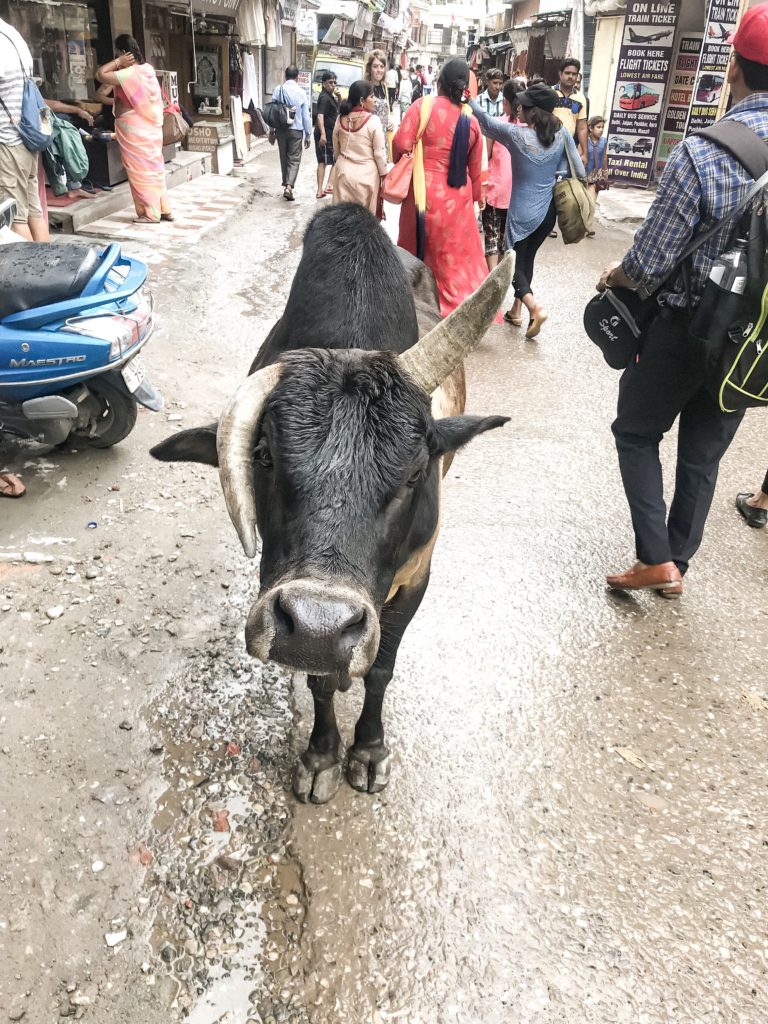
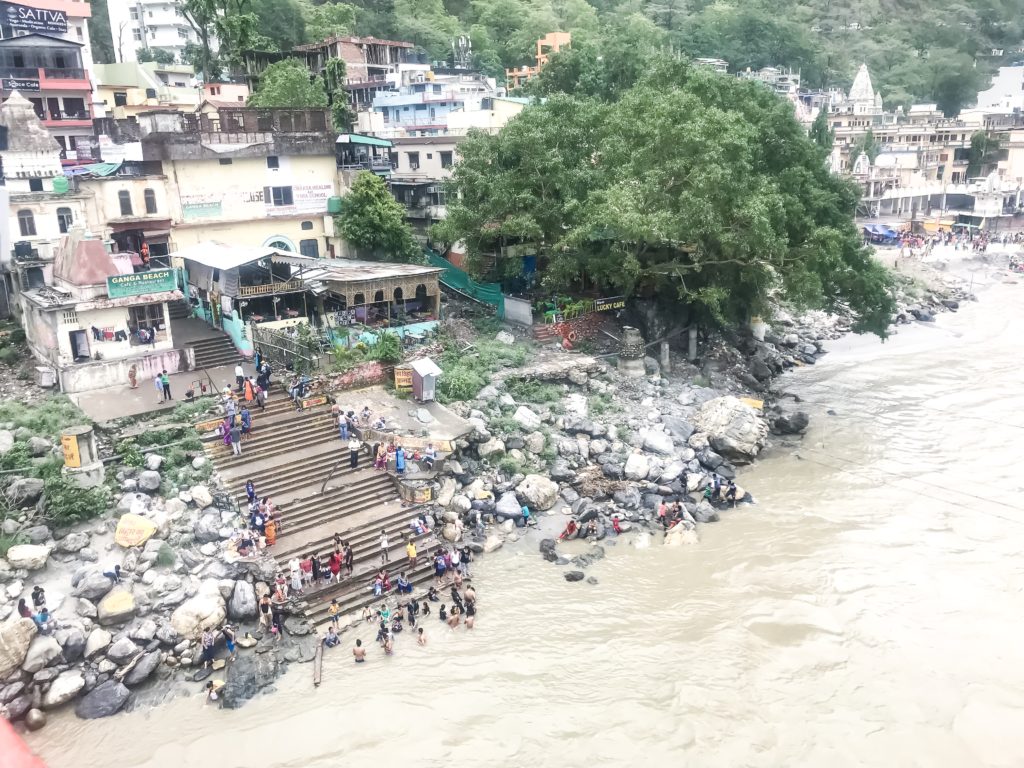
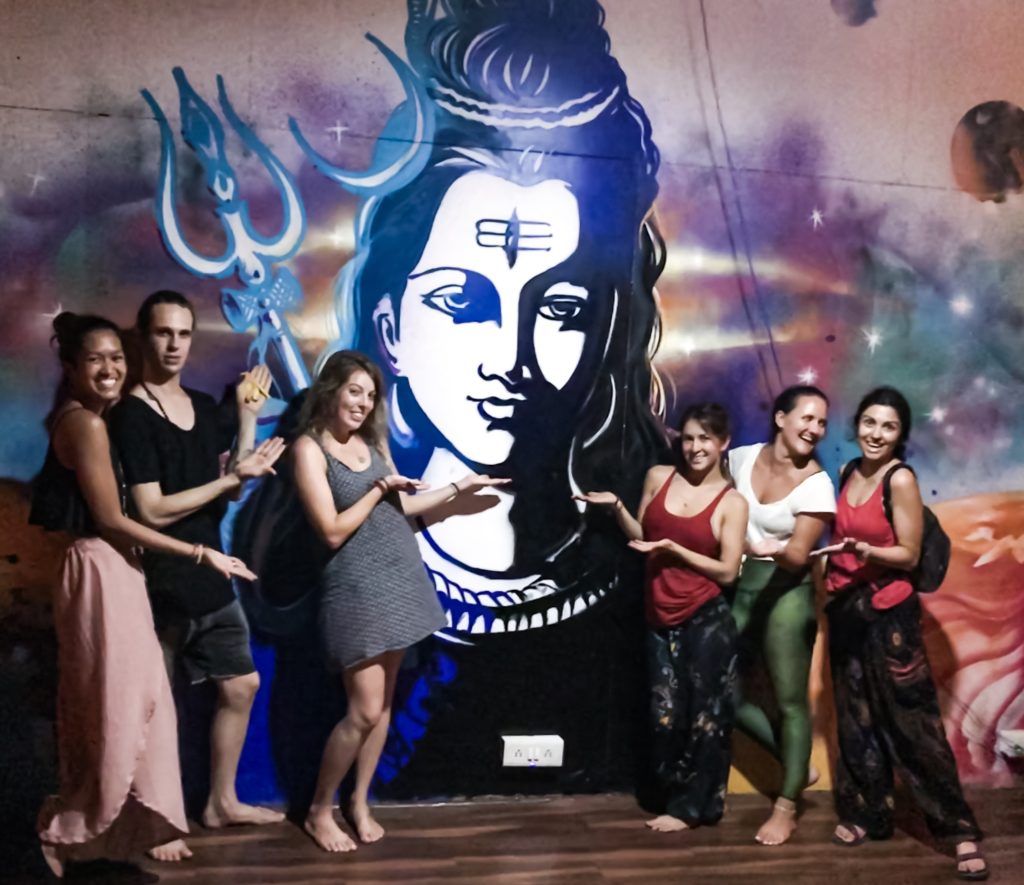
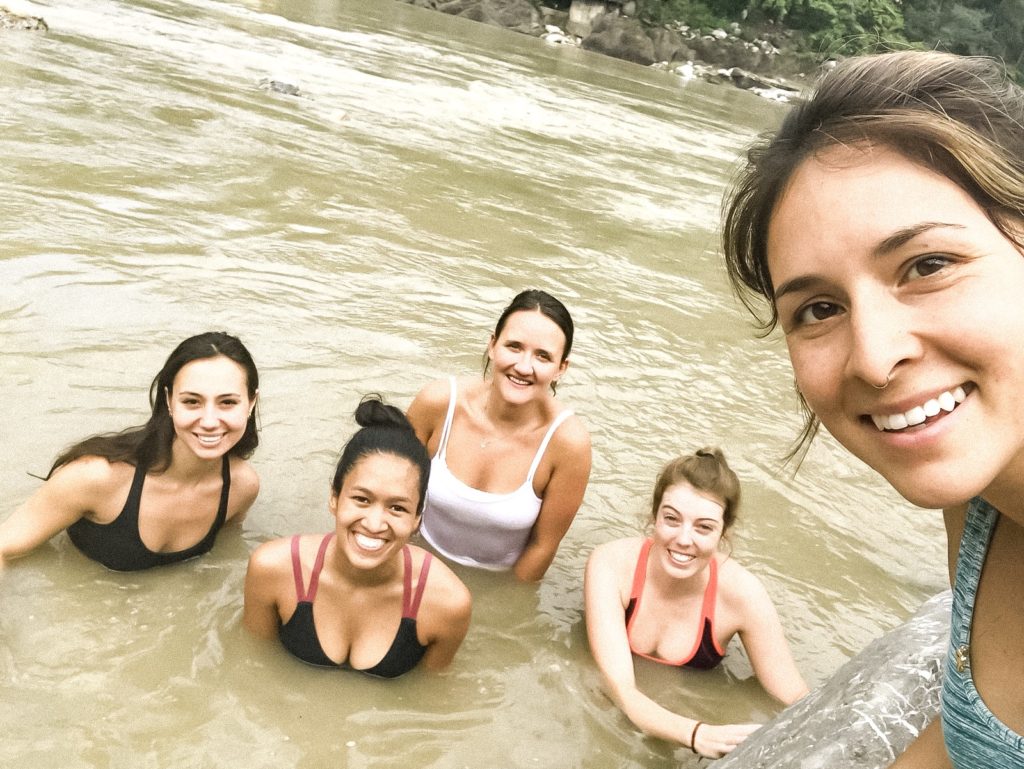
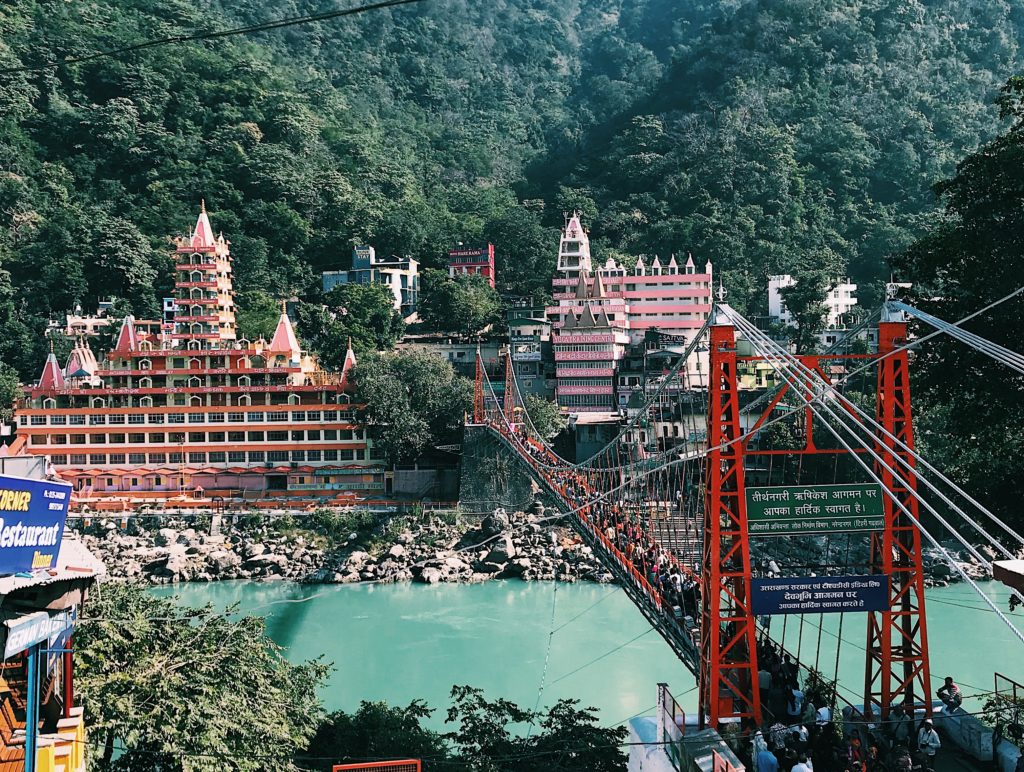
Vashishtha Meditation Cave & Neer Waterfalls
This was the only organised Sunday activity that AYM arranged for us. The program is really intense so these excursions may be the last thing you want to do, especially in the heat of summer! Stay in Rishikesh after the course ends to enjoy the adventures Rishikesh has to offer.
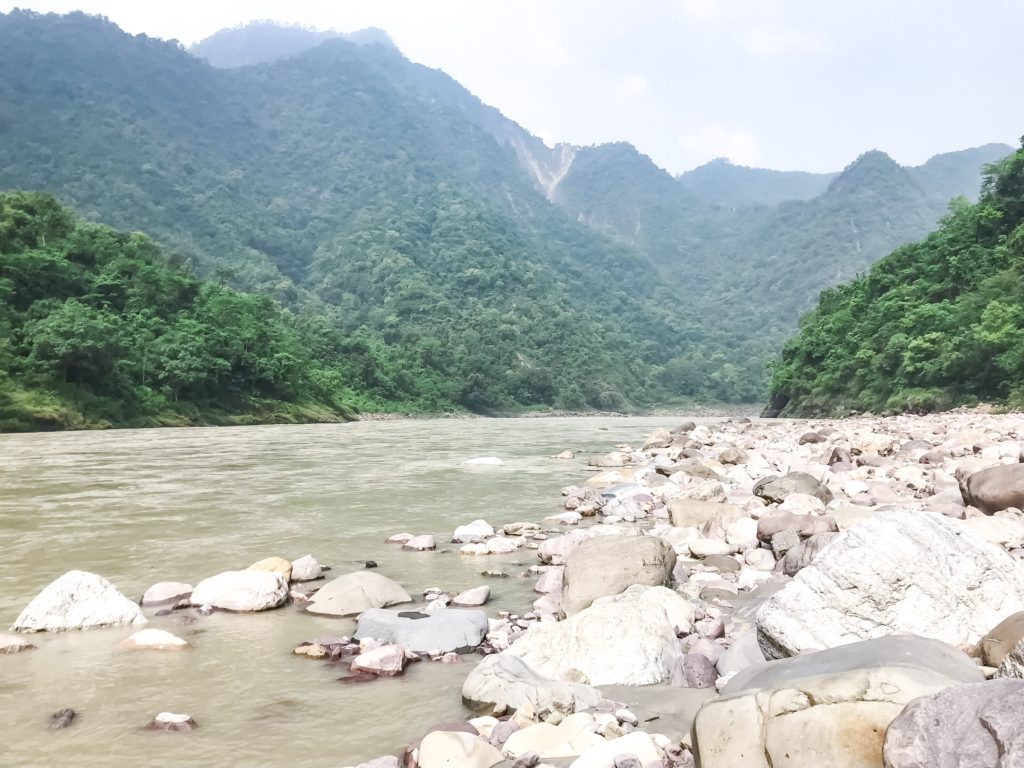
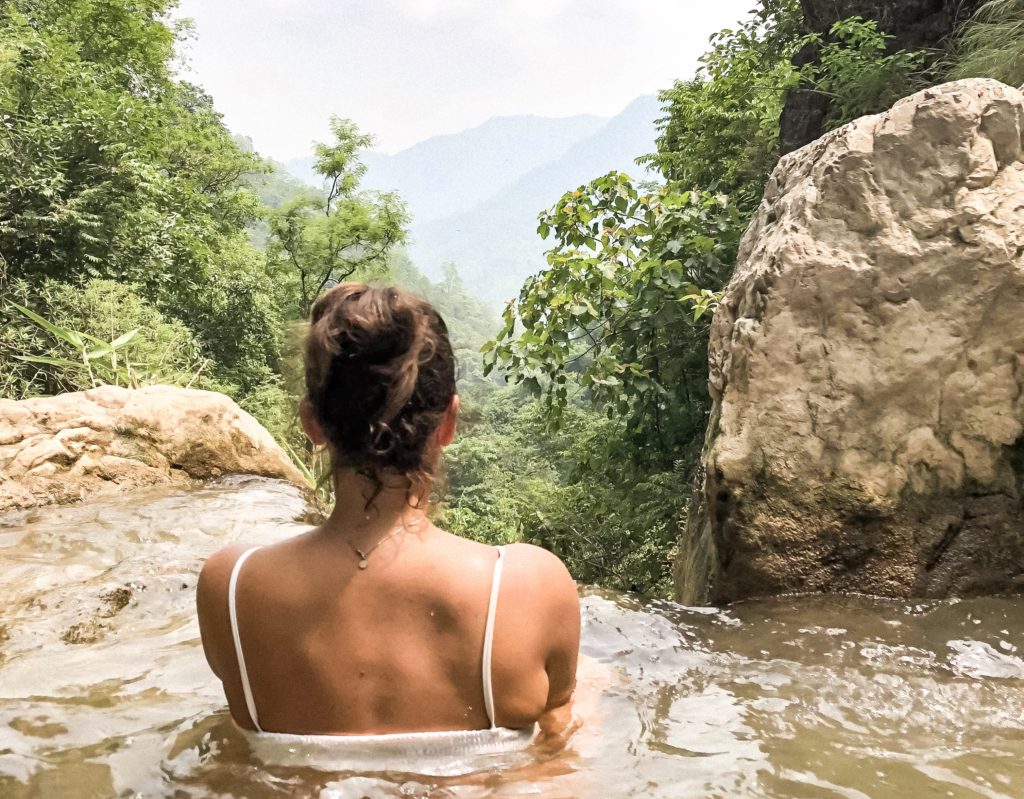
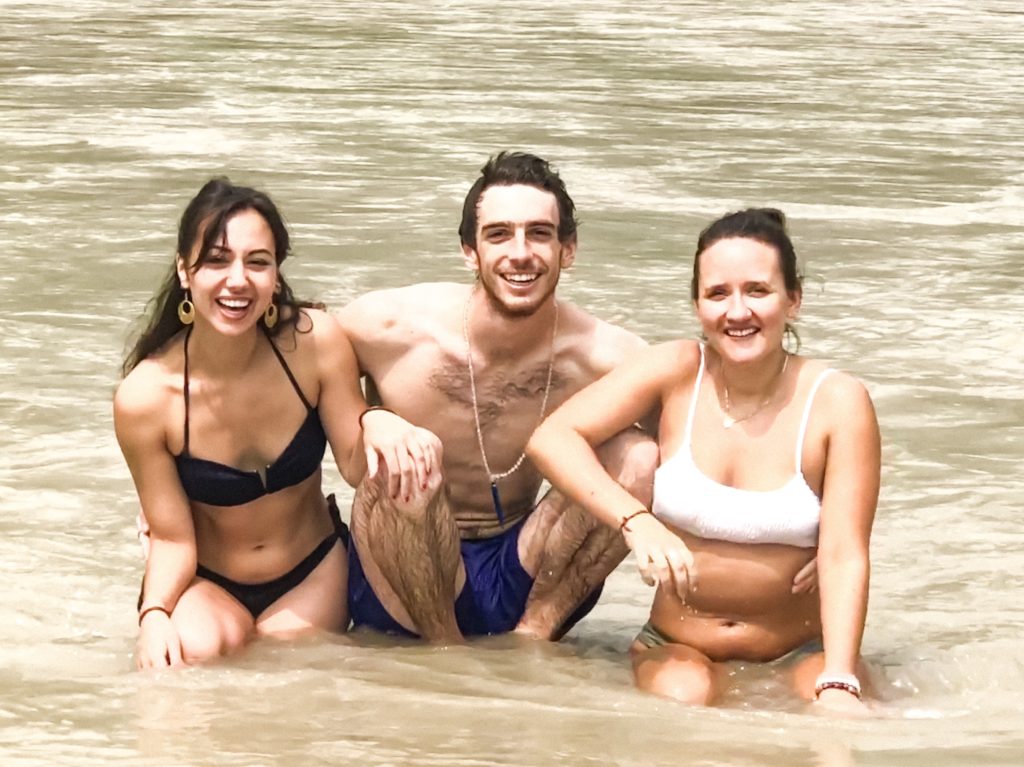
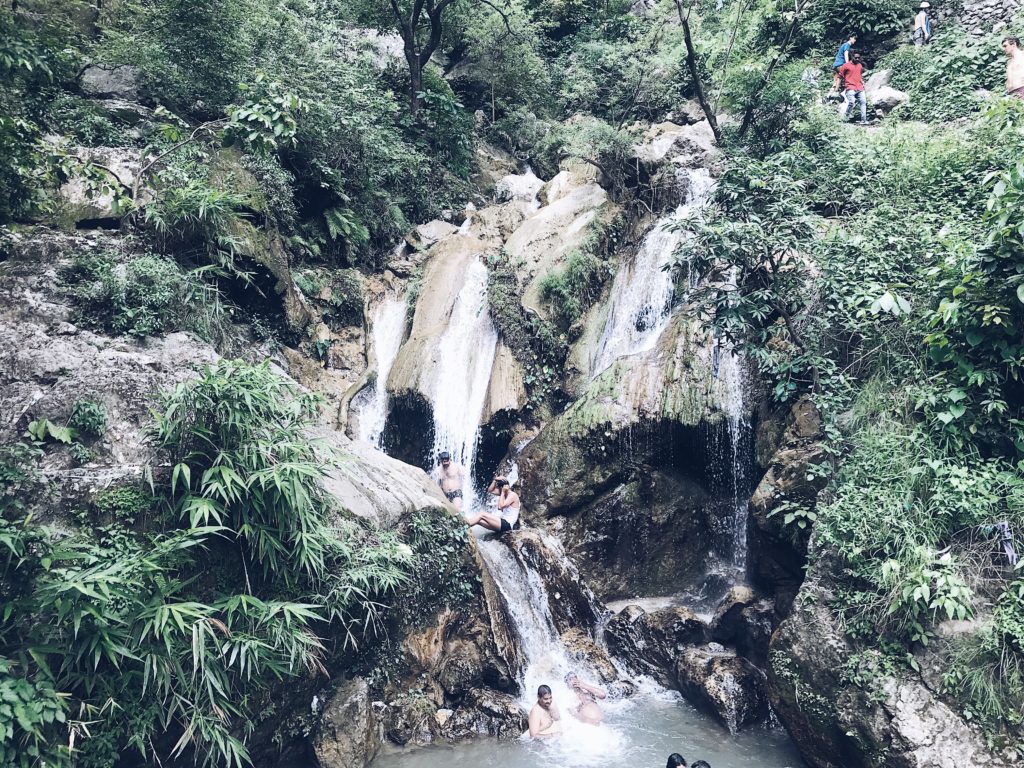
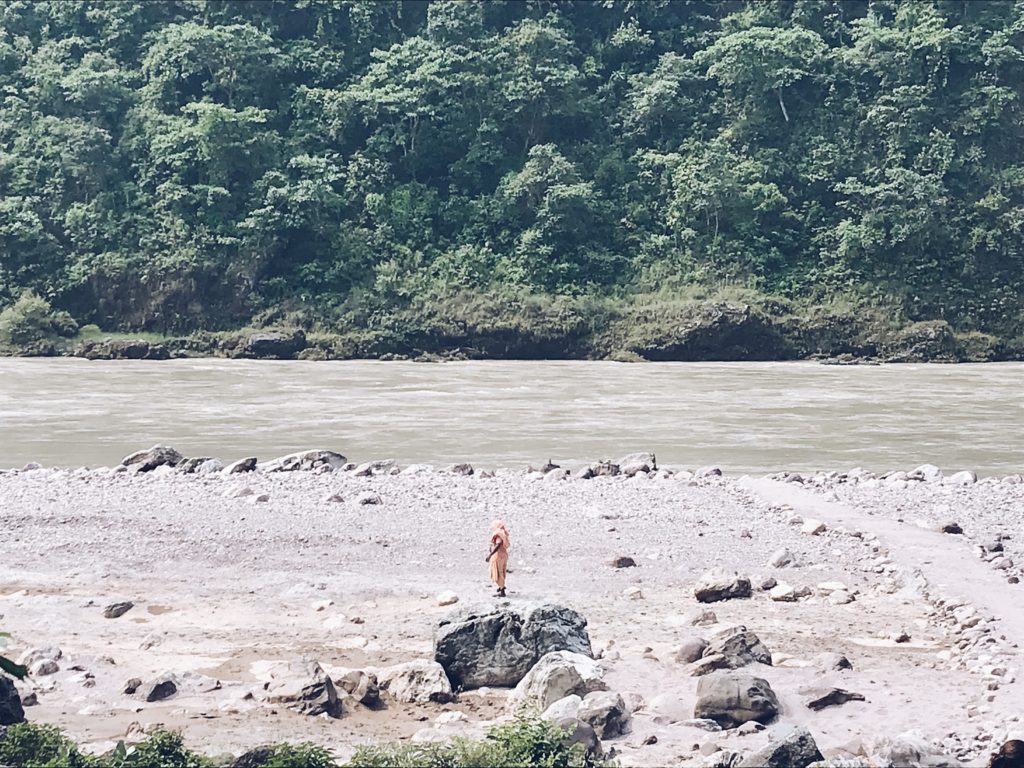
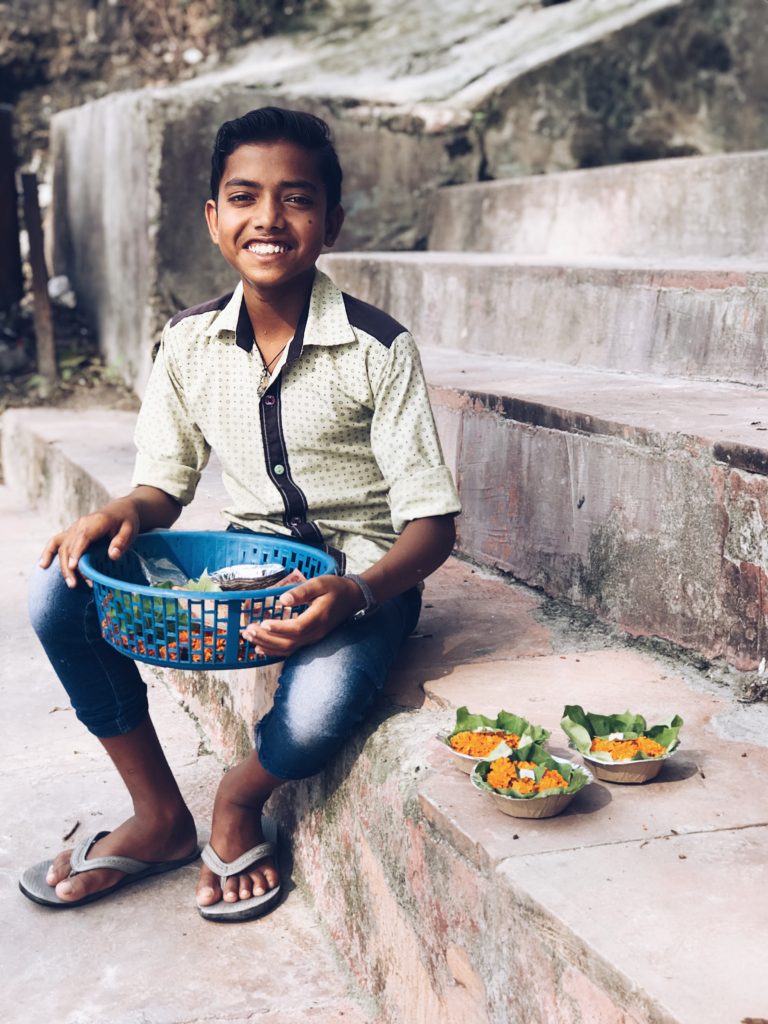
International Yoga Festival
The International Yoga Festival was on when I was at AYM. They organised for us to attend the festival in Dehradun where we got to practice yoga with the Prime Minister and thousands of others. It required a 2 am wakeup but was definitely unforgettable!
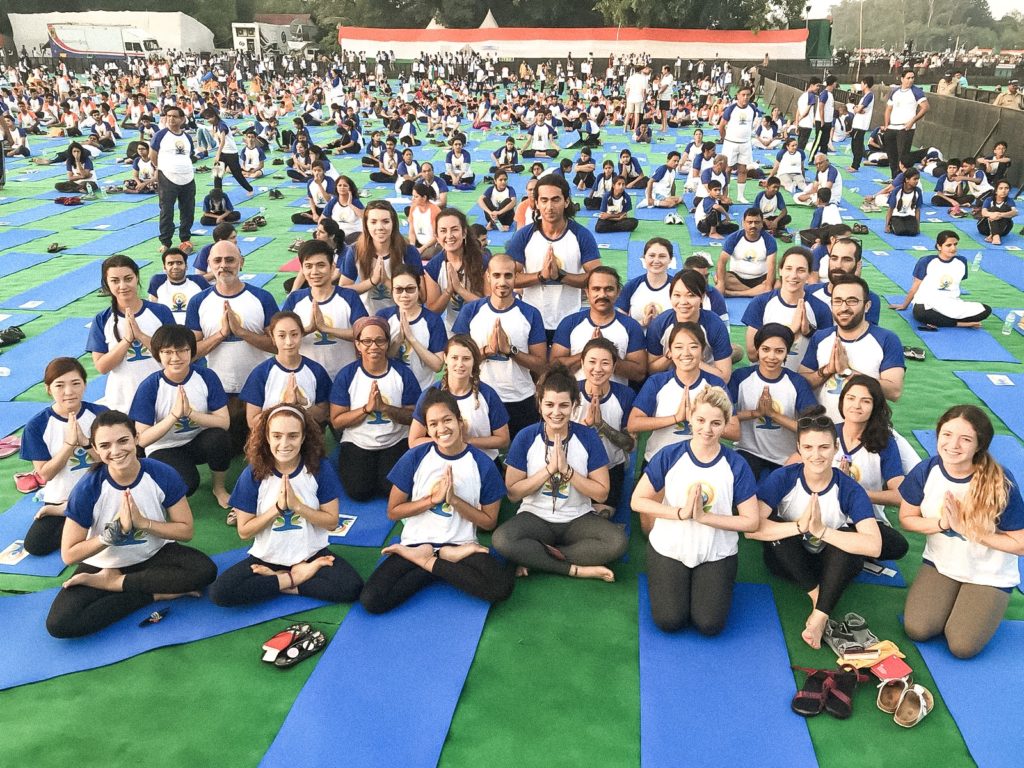
Food
3 vegetarian meals per day plus chai (tea) in the morning. Continue reading for more information on what the food was like below.
Accommodation
The accommodation included is shared or private. There is the option of aircon for an additional charge.
Airport transfers
Airport transfers are NOT included in the fee. They ask $20 for a pick up from Dehradun airport and $80 I believe for a pick up from Delhi.
This is actually a huge ripoff so if you’re confident enough I would either get your own taxi from Dehradun airport to the school for around $10 and if you are flying into Delhi you can get a taxi for around $50. The other option is to get a bus from Delhi to Rishikesh which will cost around $7 plus another $2 for a tuk-tuk to Tapovan
Location
The AYM yoga teacher training course is located in Upper Tapovan which is actually, in my humble opinion, the best place to do a TTC in Rishikesh.
It is far enough away from the madness of Laxman Jhula to have some peace but close enough to walk to. The school is far up a hill. This prevents distractions from the market and helps you to better focus on your studies and practice. This hill was killer in summer!
AYM is off the main road that connects Rishikesh Market to Tapovan and Laxman Jhula. This means it is easy to get tuk-tuks to other parts of Rishikesh and it is where all the ATMs are. This road has two amazing organic stores, filled with all the things you thought you would never find in India! Plus there are loads of amazing cafes in the area as well as really good dabas and local street food.
Another amazing thing about the location is that it is really close to nature up in the hills. In fact, if you keep walking up the road that AYM is on for about half an hour you will reach a secluded and lesser-known waterfall which is so beautiful! It gets sun all day long in the winter, whereas lower down in Tapovan and on the other side of Laxman Jhula it is in the shade most of the day and quite cold.
Since I did my training less than a year ago there has been a load of development on that street as well with some new beautiful cafes and shops. There is a really cute yoga clothing shop which recently opened. It is the only place in Rishikesh you can buy yoga pants not made with cotton. Essential in the heat! There is a cute cafe next to their shop, both are called Rise and Shine.
Ira’s Kitchen is down the road, which is rated number 1 on Tripadvisor and for a good reason! They have AMAZING home-cooked Indian food and the best chai I’ve ever had still to this day, and I’ve been in India for nearly 1 year!
Another top cafe pick just down the road is The Eat Story. We used to waste our Sundays away under the fans in this cafe. They have really good food and lots of different options on their menu, especially if you’re craving some good Western or Chinese food! It’s a bit pricey but worth the treat on your days off!
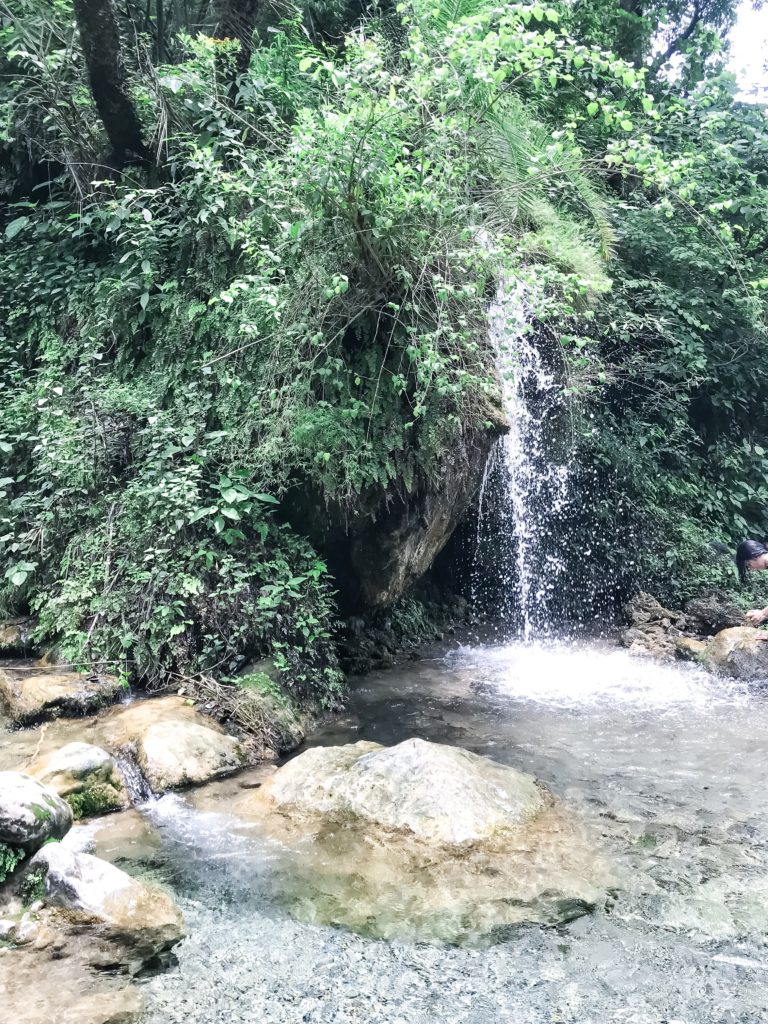
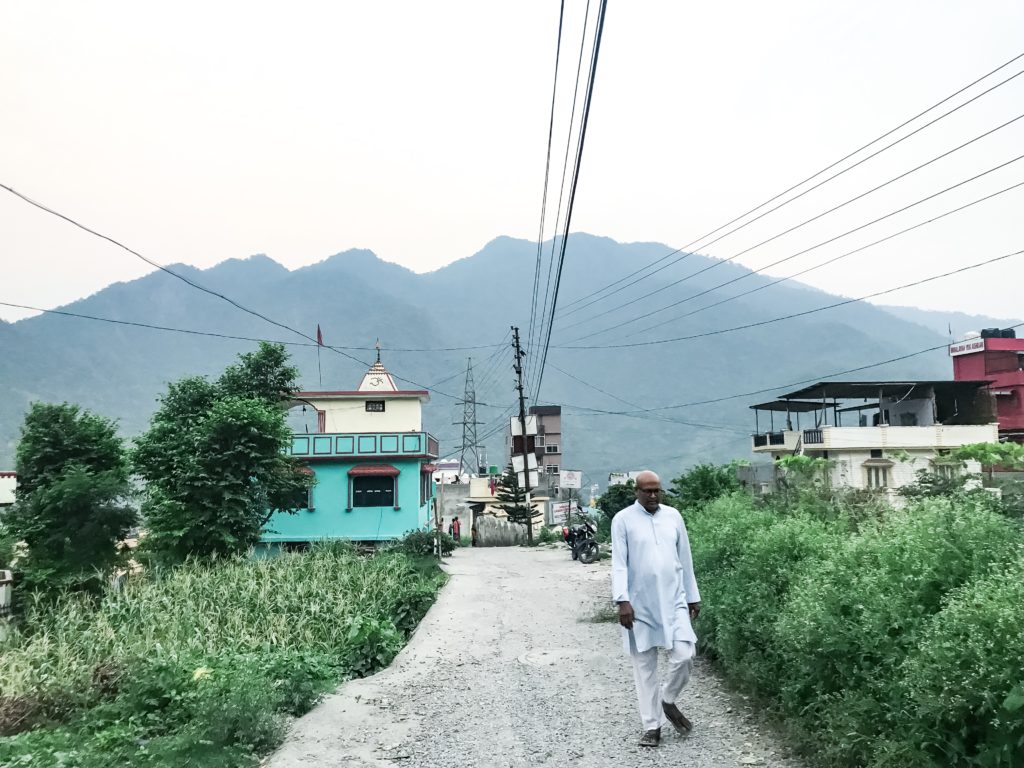
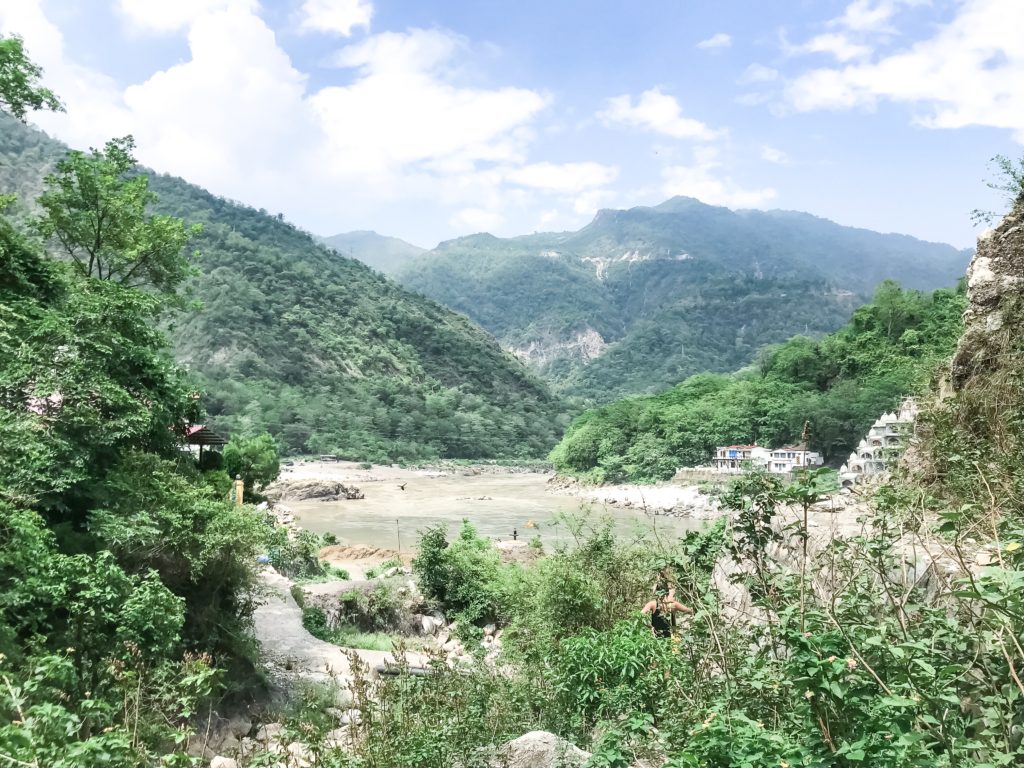
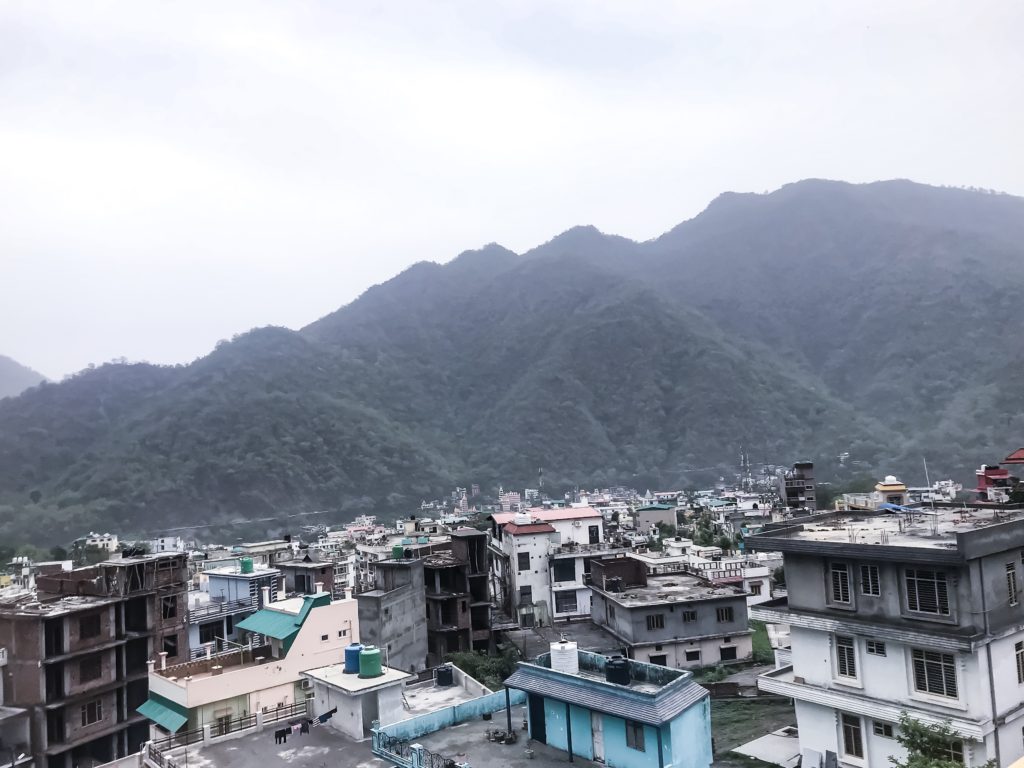
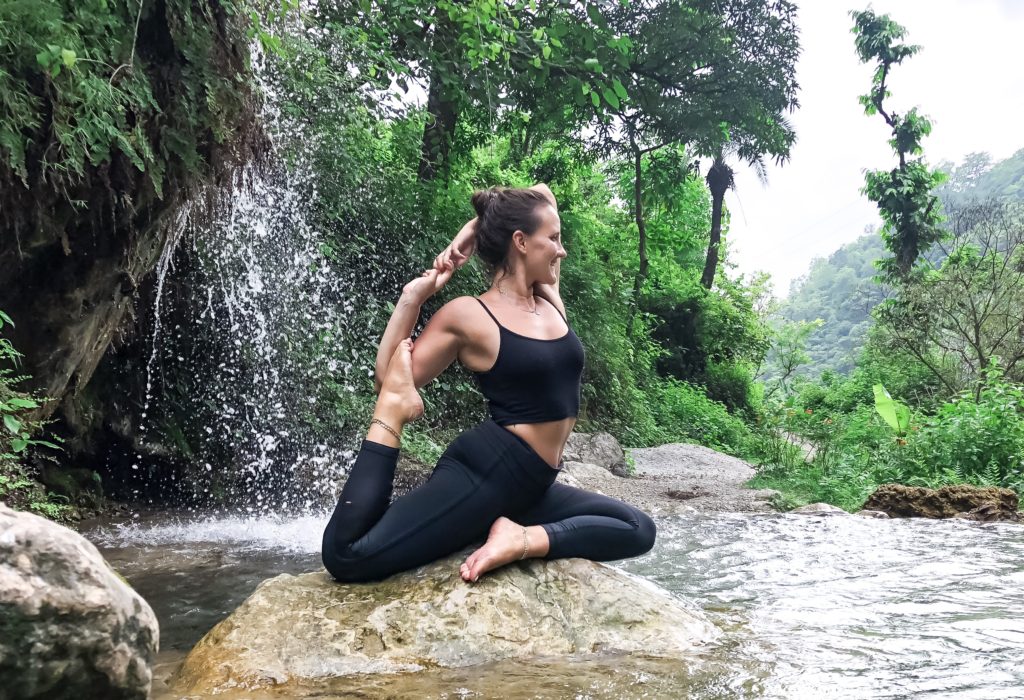
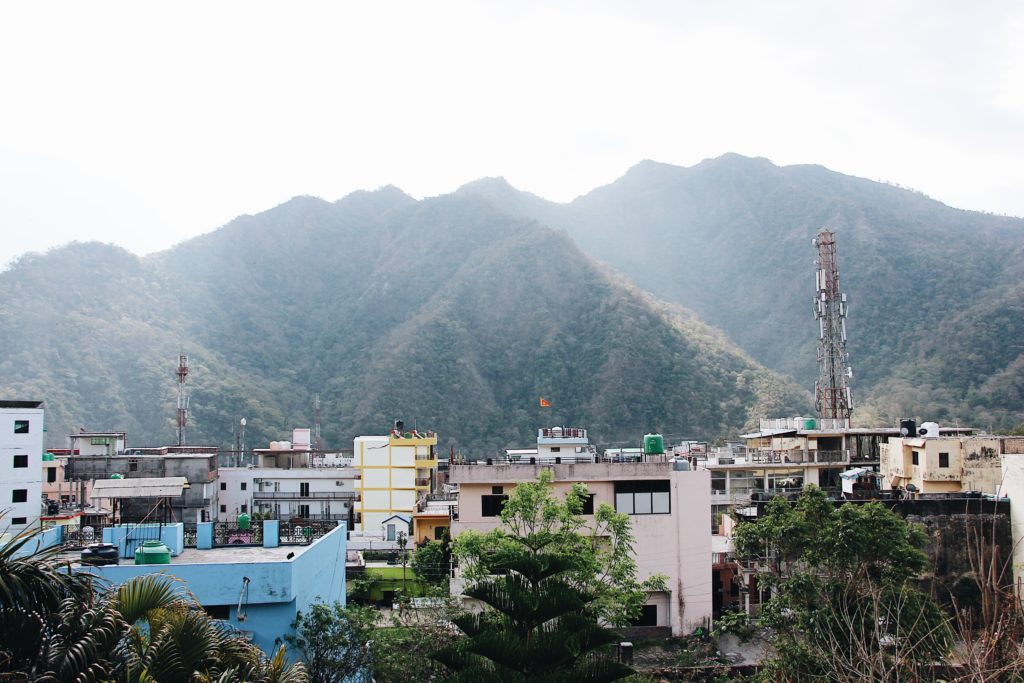
School Facilities
AYM had some really good facilities and I was really happy with my experience of what the school had. Please note that the school is ‘ashram’ style so it is not fancy by any means like some other schools that you see in tropical Asian countries. The price reflects this! A school in Bali will set you back around $4000 exclusive of accommodation.
Garden and Cafe
There is a cute garden with a cafe at the school which is probably my favourite thing about it!
Every evening we would all sit around, drink chai, eat chocolate balls, share stories and get to know each other better.
It was really our place to hang out as there’s not really any other common area. There was a bit of shelter as well so even if it rained we could still chill there. Also having a cafe on site was amazing! I’ve walked past AYM recently and it looks like they have upgraded their cafe even more which is great.
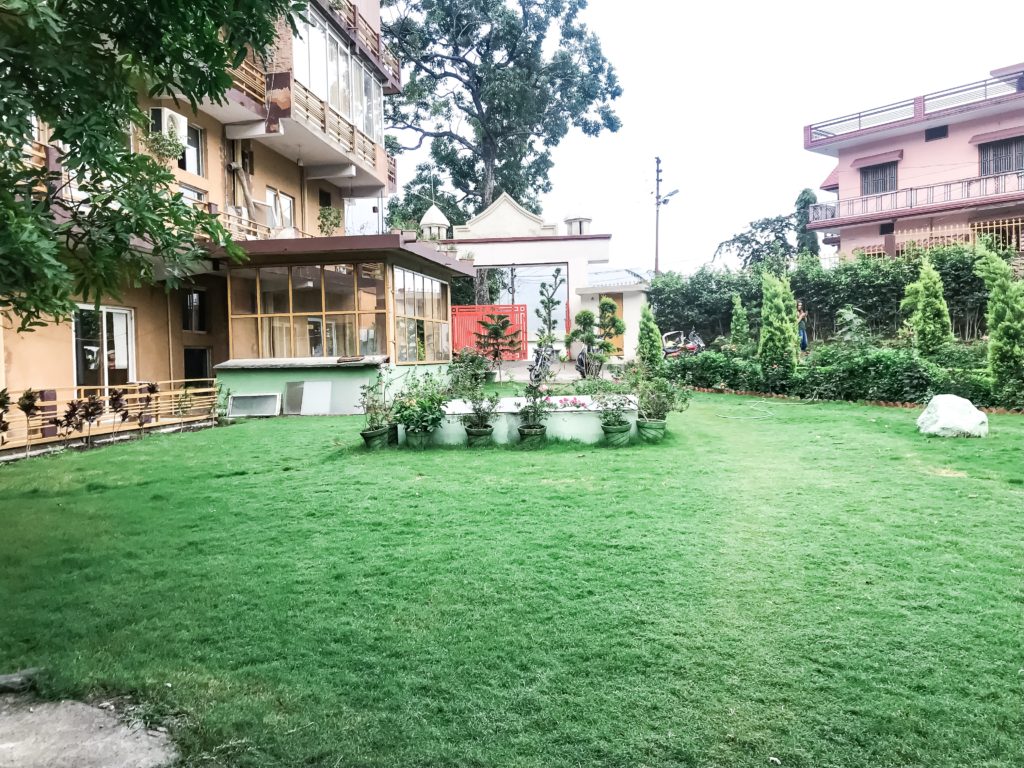
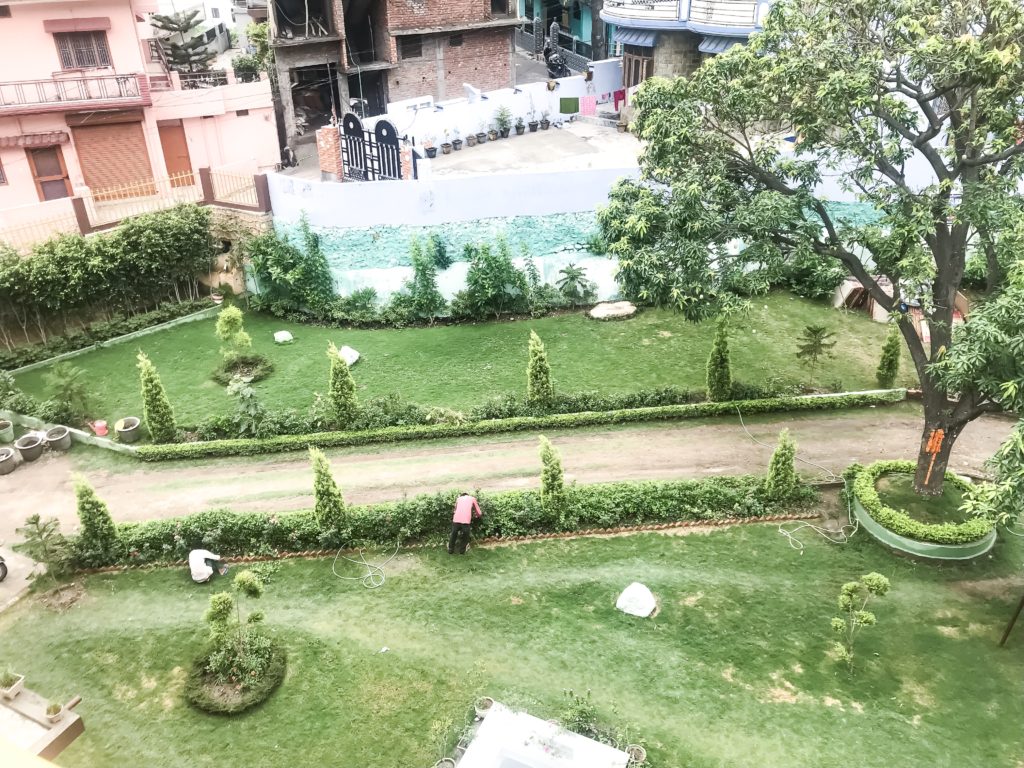
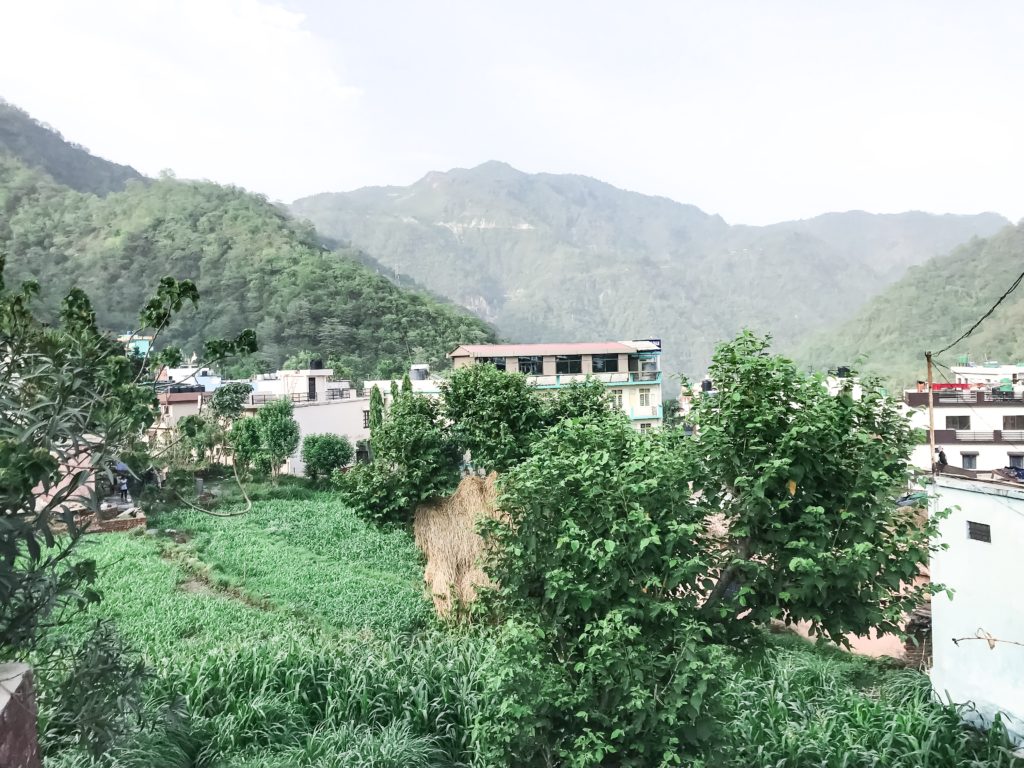
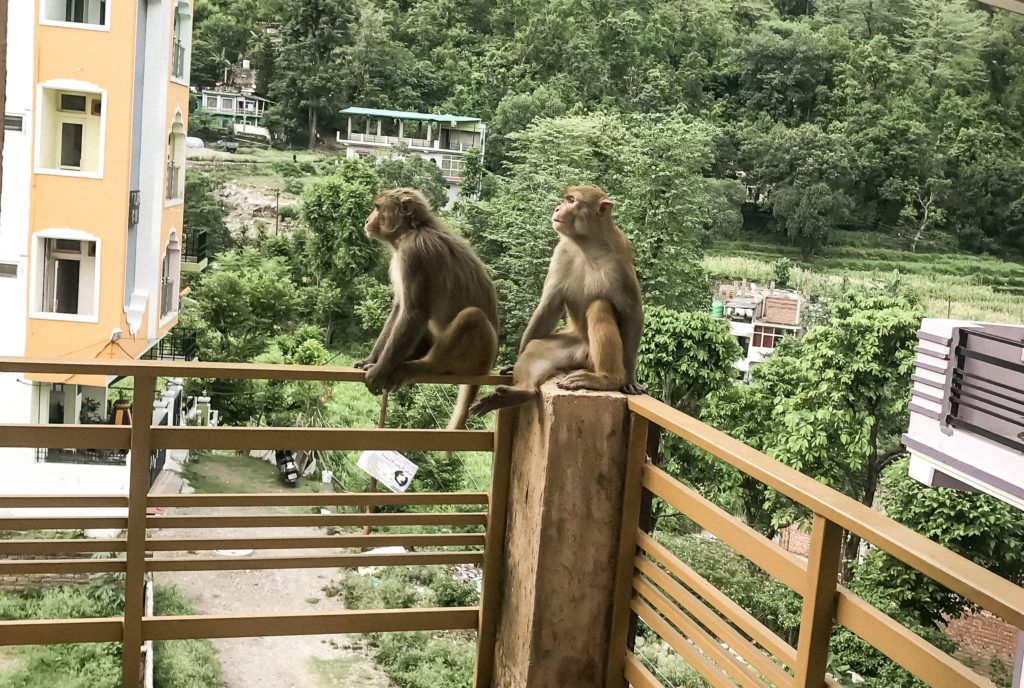
Yoga Halls
There were two yoga halls in the main building used for the AYM yoga teacher training course. One big hall on the 1st floor and another slightly smaller hall on the roof. I spent half of the course in each hall.
The big yoga hall was really beautiful. It had big windows with views to the mountains, hard wood floors, fans and air conditioning. There were also plenty of blocks, bolsters, straps and yoga mats for us to use. I recommend buying a yoga mat or bringing one from home. The ones at the school are really cheap and slippy- not good for sweat!
The yoga hall on the roof wasn’t as good because it was smaller and didn’t have the nice windows or floors as it was an add-on to the roof. However, it was still okay and had all the equipment and props we needed.
The asana classes are split between the two yoga halls. The other lectures were all in the big yoga hall. You will be spending most of the day sitting on the floor. Your body probably won’t be used to this and it can get very uncomfortable even with all the bolsters. If you decide to lie on your stomach you will 100% fall asleep! Wall space becomes very valuable!
A note about the air conditioning and fans in the yoga halls- while this was great to have for the lectures our teachers would always turn them off during practice, in particular, ashtanga. Air blowing and artificial temperatures aren’t allowed when practising ashtanga. This builds your inner fire.
In June it was like doing hot yoga combined with the most intense ashtanga you could imagine. I have never sweated so hard in my life! I started to love it by the end though!
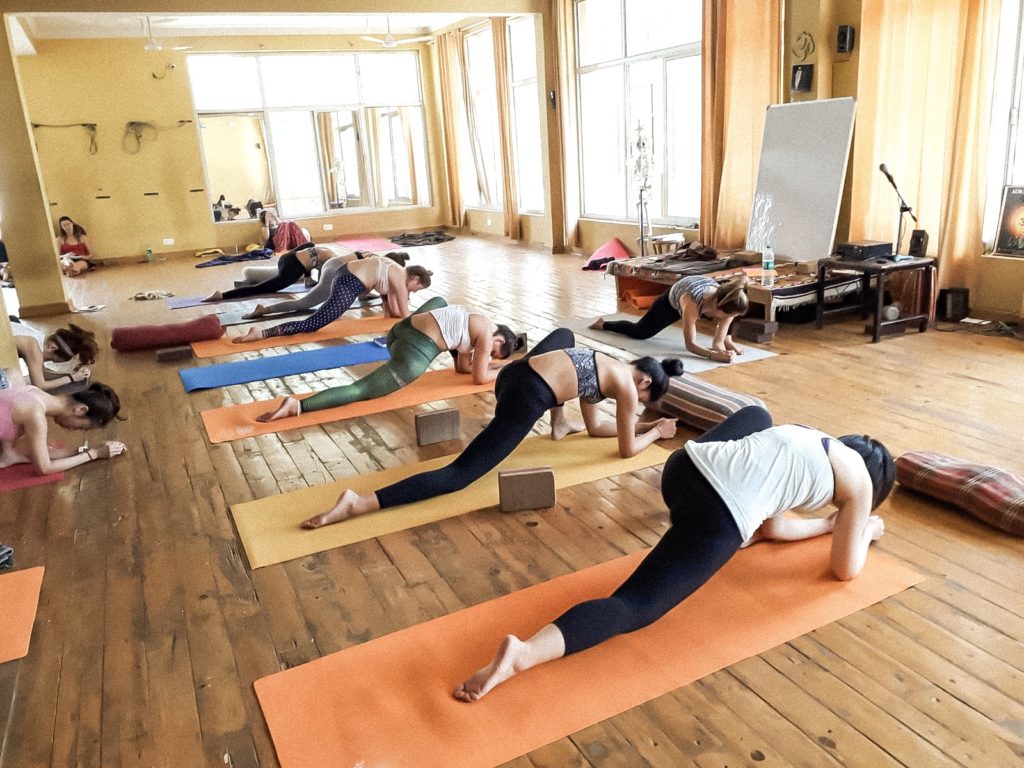
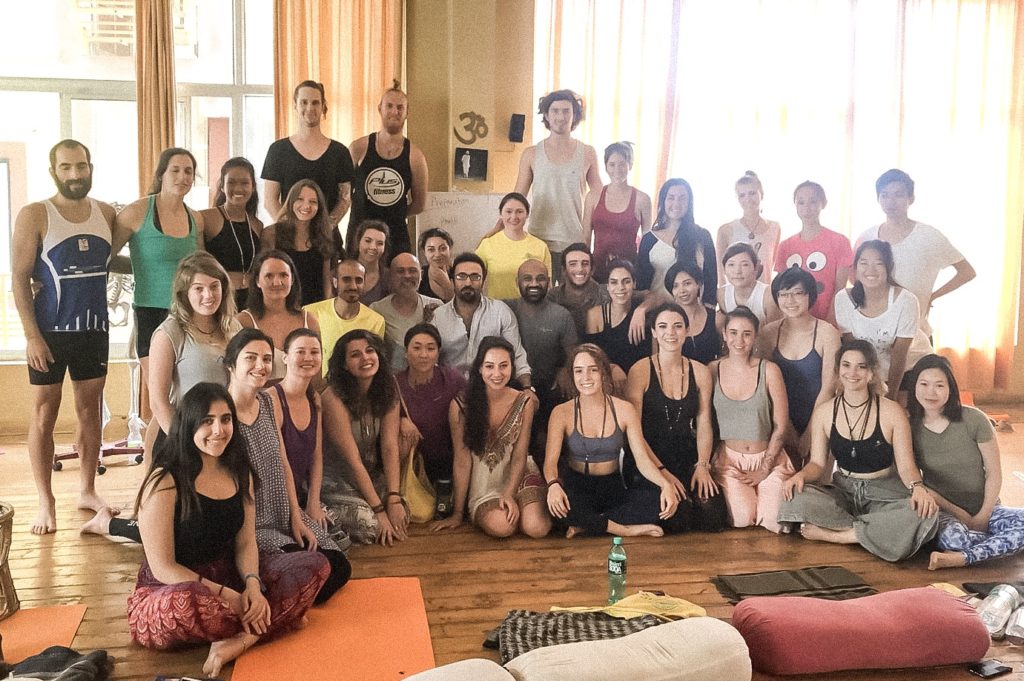
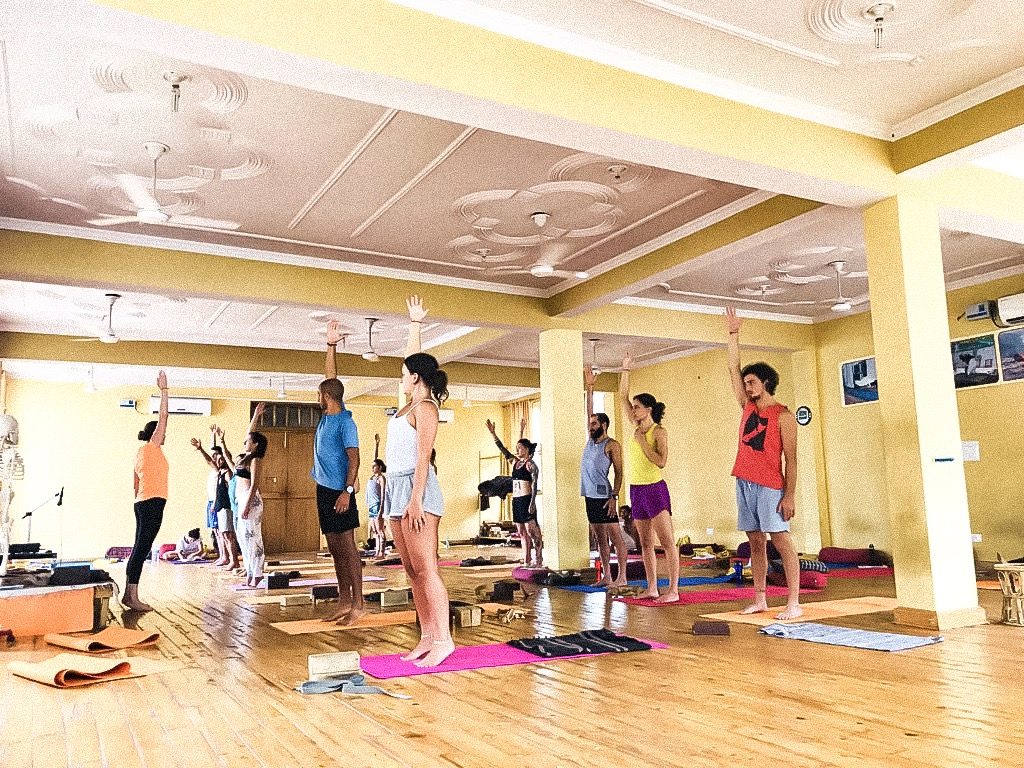
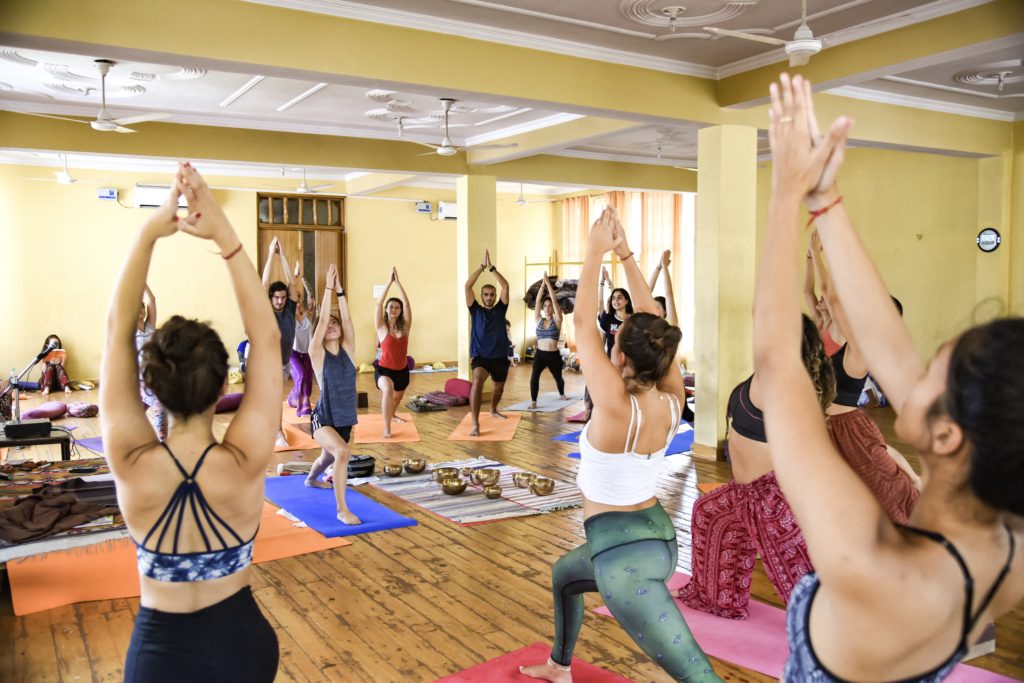
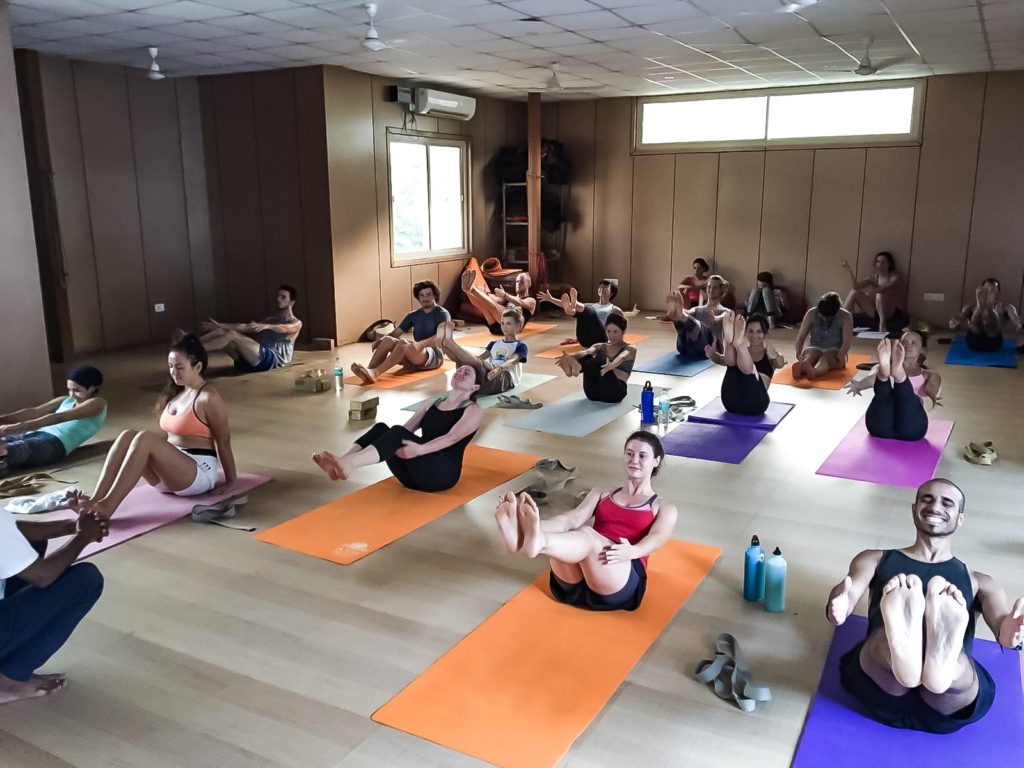
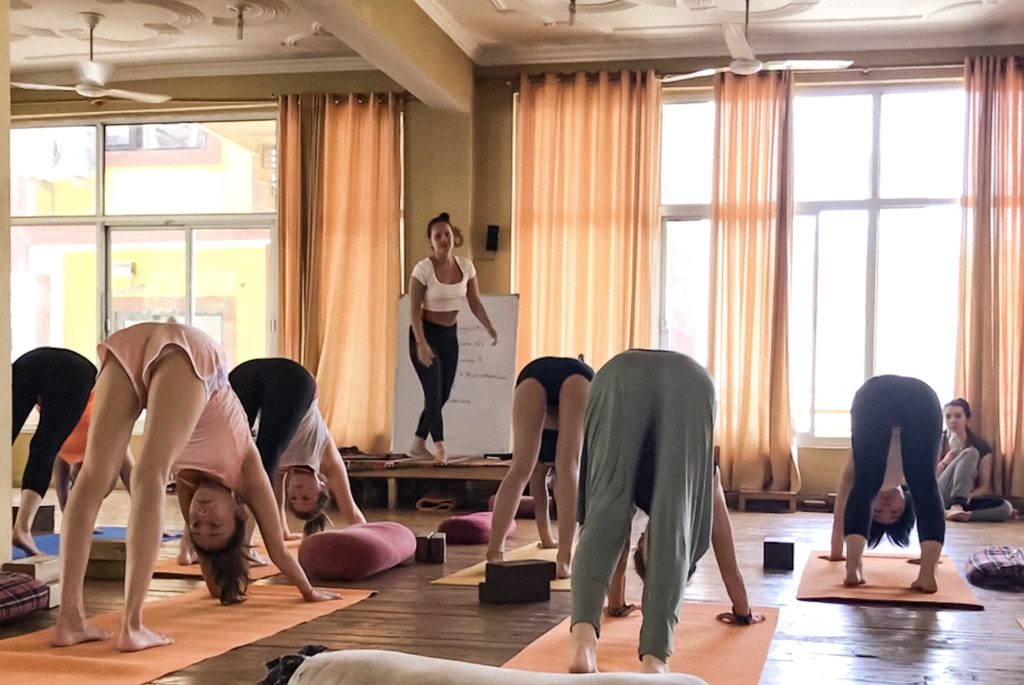
Rooftop
There was a rooftop that you could go on but there was nothing really up there in terms of chairs and shelter so we didn’t hang out up there. It’s a nice place to do some self-practice. I believe since I completed my yoga teacher training course at AYM they have done some construction on the roof so it may be different now.
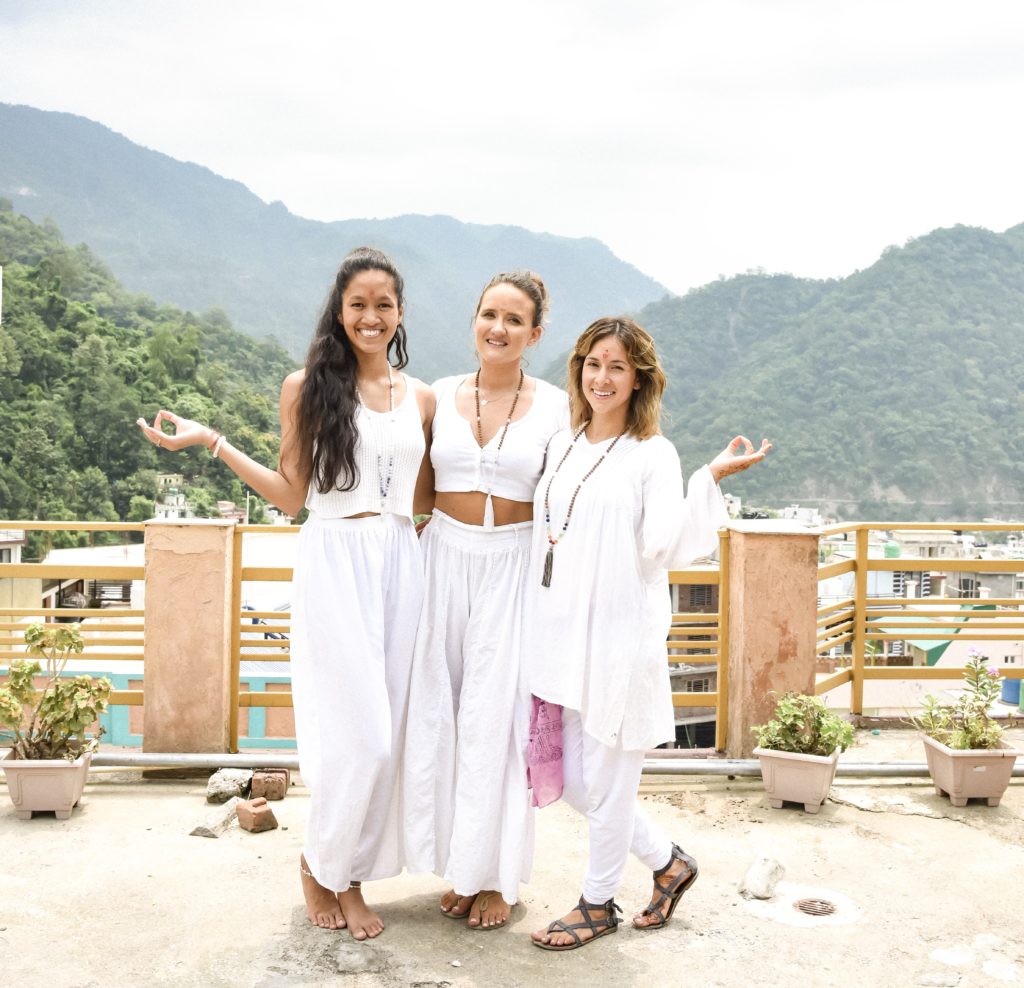
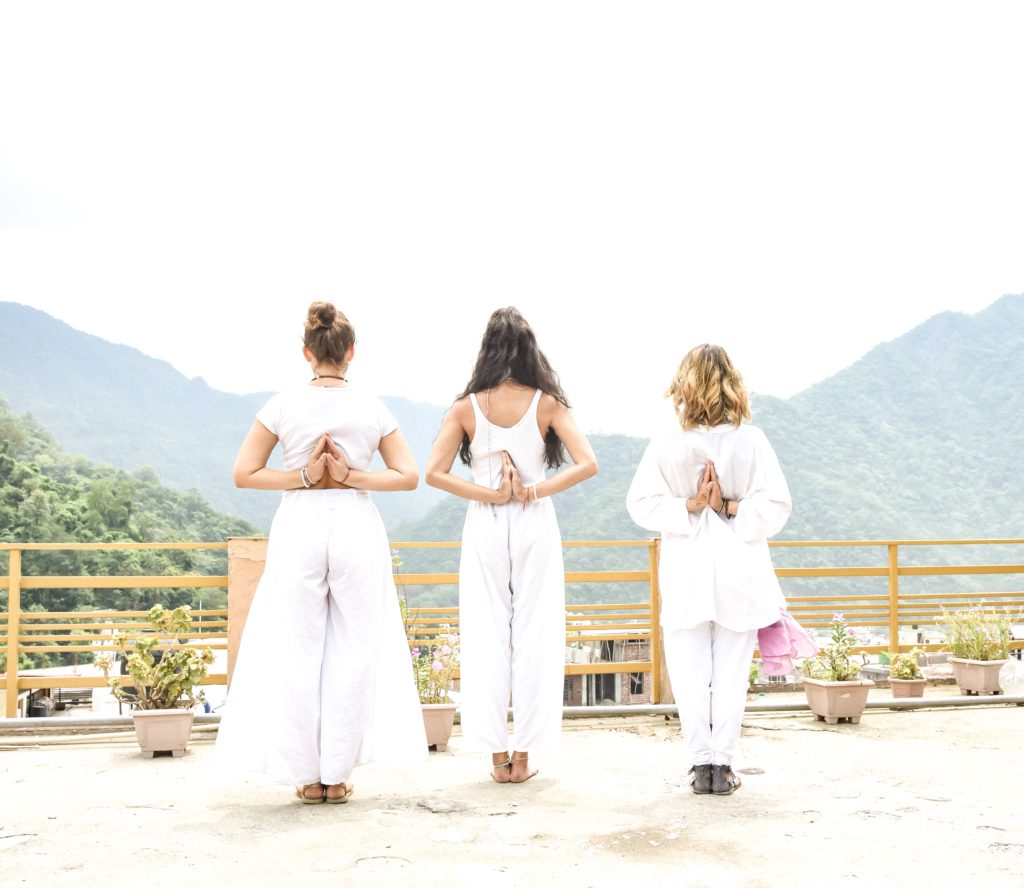
Dining Hall
The dining hall was basic but totally fine. There were some tables and regular chairs as well as low tables where you can sit on the floor and eat. Every meal was self-served and you wash and put away your own dishes. There is a selection of stainless steel tableware to choose from!
Photographer
Not sure if this counts as a facility! But there is an onsite photographer who comes and takes pictures of ceremonies and classes to share on social media. So be aware that you might have a guy with a big camera clicking your picture while you’re sweating your ass off in navasana!
But here is a pro tip if you want some nice pictures taken! Go to their office and kindly ask for a photoshoot from him. You are more than welcome to do this and he will give you the images on a USB.
A couple of friends and I did this after our closing ceremony and it kind of backfired because he directed us to do the most cheesy poses on the roof which now I just find hilarious!
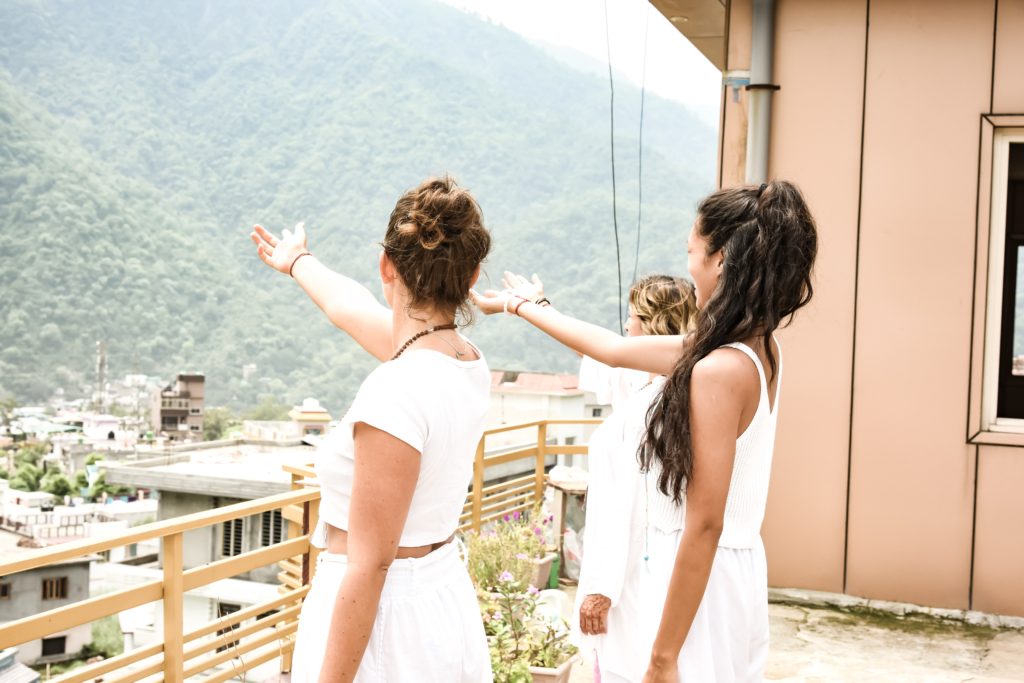
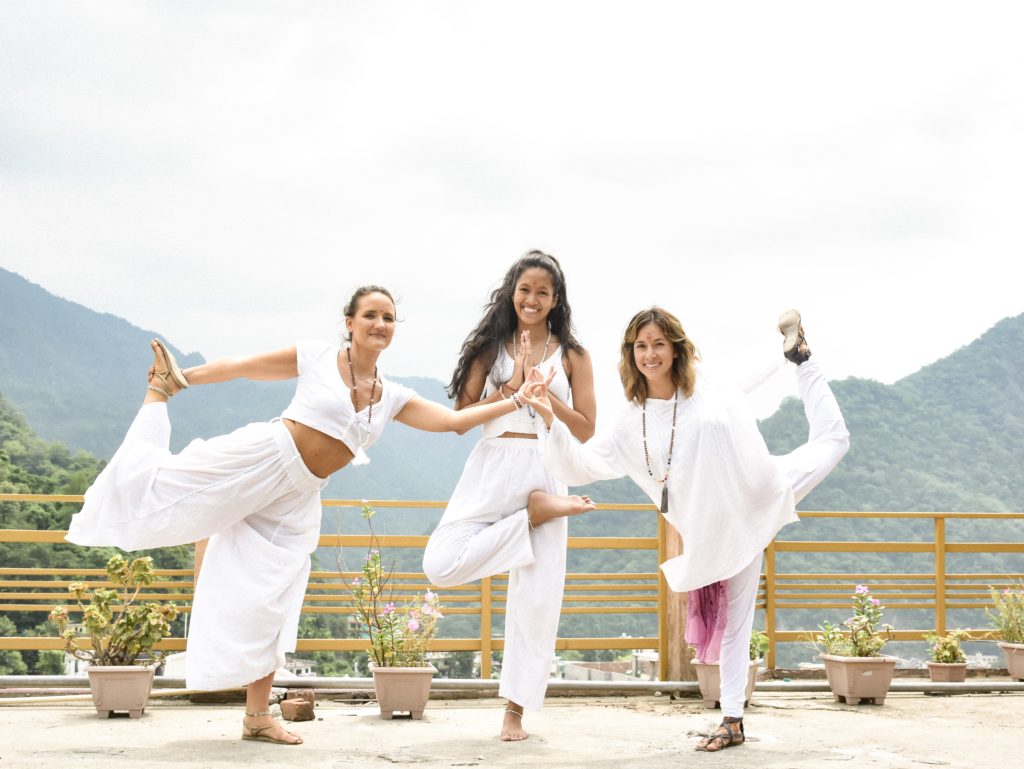
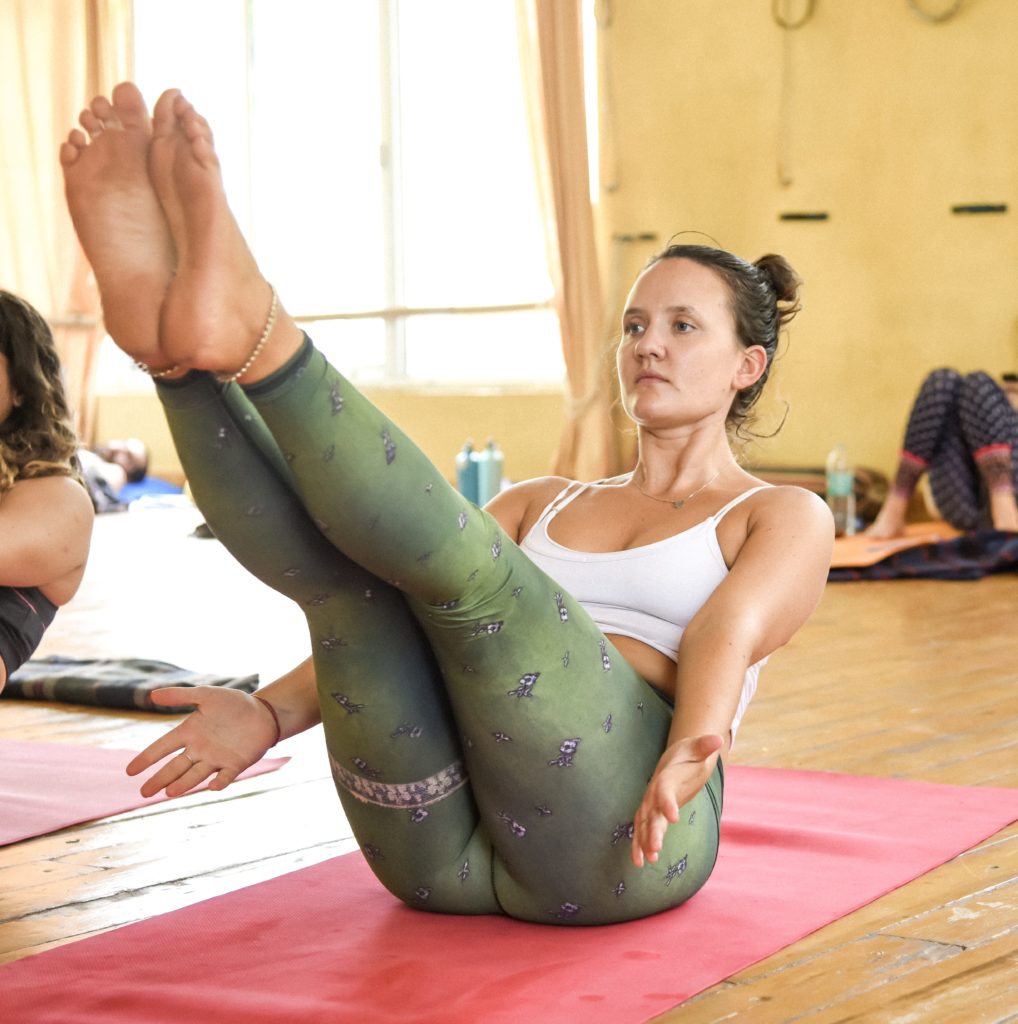
There is a generator
This is worth mentioning because there are power cuts constantly in Rishikesh, which can be a real pain if there is no generator. It means no fans, no aircon, no wifi, no hot water and sometimes the water cuts off completely.
AYM has a generator so every time there is a power cut during the day it gets turned on. The generator isn’t turned on during power cuts at night. The only reason you will know is if it is summer and you wake up in absolute sweats because your fan is off!!
Accommodation
Bedrooms and Bathrooms
The quality of your room is kind of up to a matter of luck. Not every room is the same and not every room is equal! There are also two buildings. The main building holds the 200 hour students and the second building holds the 300 hours students and any extra 200 hours students who can’t fit in the main building.
Some rooms have balconies and views of the mountains, some rooms are bigger than others with a variety of colours and some are on the lower floors backing onto the garden or the dining room (not as nice!).
My room was on the bottom floor literally right by the reception. People are always walking past to go to the dining hall. There was no balcony or view which I hated at first but grew to appreciate as it meant my bed was right by the wifi router!
My room was also really big with heaps of space to dance around. I had a single bed, a wardrobe and full-length mirror as well as a chair and desk. Every room also has an attached bathroom with hot water.
It’s Indian style so expect wet floors and buckets! Also, note that they do not provide toilet paper or towels so you will have to buy your own! There are a number of stalls to get supplies from just outside the gate.
Also it’s worth pointing out that you should bring earplugs regardless of which school you choose because dogs like to have LOUD barking competitions all night long. This was the main thing that kept me awake at night and not just in Rishikesh but most places I have been in India and Nepal.
Wifi
The wifi in the school was pretty bad. I think I’m the only one that got to really use it because of my proximity to the router. It is slow and doesn’t always work and in the other building, I don’t think it hardly worked at all.
But this shouldn’t really be of concern to you because you should 100% get a SIM card as soon as you get to India. Data is plentiful and dirt cheap so you can just use that and hotspot your other devices. Check my tips at the bottom for more about SIM cards.
Laundry
There are manual washing machines that you are free to use (if they are working!) and clotheslines to hang your clothes. Or you can just hand wash in your bathroom. If you’re super lazy there are laundry services on the same road as AYM just further down.
You will have to buy your own washing powder, which is available from the little shop right outside the gate (along with snacks, treats and drinks to keep you satisfied!)
If you need fresh sheets they are available from reception, just ask.
Cleaning
During your teacher training course no one is going to clean your room or empty your rubbish. You will need to do this yourself! You can borrow cleaning supplies from reception. Taking rubbish out was awful because there is no proper waste system in Rishikesh, I would just throw all my shit (literally) onto this big pile outside the building where the donkeys, monkeys and cows hang out for lunch. Welcome to India!
Safety
The front gate gets locked at 9.30pm or 10pm. You are supposed to be inside the school before then. Although there was a way to sneak in through the second building which they may have since fixed. I never had any safety or security concerns from the staff, other students or outsiders the whole time I was there.
Food
We were served 3 meals plus tea everyday. The only exception is on Sunday they don’t serve lunch as most people are out and about anyway!
Personally, I really loved the food! I love Indian food and loved that you could eat as much as you wanted. I also have quite a strong stomach when it comes to eating food in a foreign country.
There was definitely an adjustment period for my stomach to get used to all the different food, but this is common with everyone!
Breakfast
Before our first asana class of the day, we would be served tea with the option of black or milk tea.
After the asana class breakfast is served. Typically for breakfast, we would be given a bowl of fruit every day plus oats, pancakes or poha (savoury Indian puffed rice dish) which varied day by day.
Lunch and Dinner
The type of food we received for lunch and dinner was pretty similar. It would consist of rice, chapati, salad, dhal and a veg curry. Plus they have all sorts or pickle and condiments available to flavour your food.
The type of veg curry we would get varied day by day, sometimes it would be jackfruit, tofu, pumpkin, potatoes or spinach. I really loved these curries! I must admit the food wasn’t exactly sattvic as there were a lot of spices and some oil.
The chefs were happy to cater to people with sensitive stomachs by serving plain rice dhal and boiled veggies especially for them. They also cater for dietary requirements like vegan and gluten-free, you just need to make sure you tell the owner, Mahesh, as well as the kitchen staff of your requirements!
If you need extra snacks throughout the day they are easy to purchase at nearby shops. The organic stores on the main road are full of healthy snacks and treats too, perfect for yogis. You are also free to skip meals and eat out if that’s what you’d prefer! You just need to let the kitchen know ahead of time.
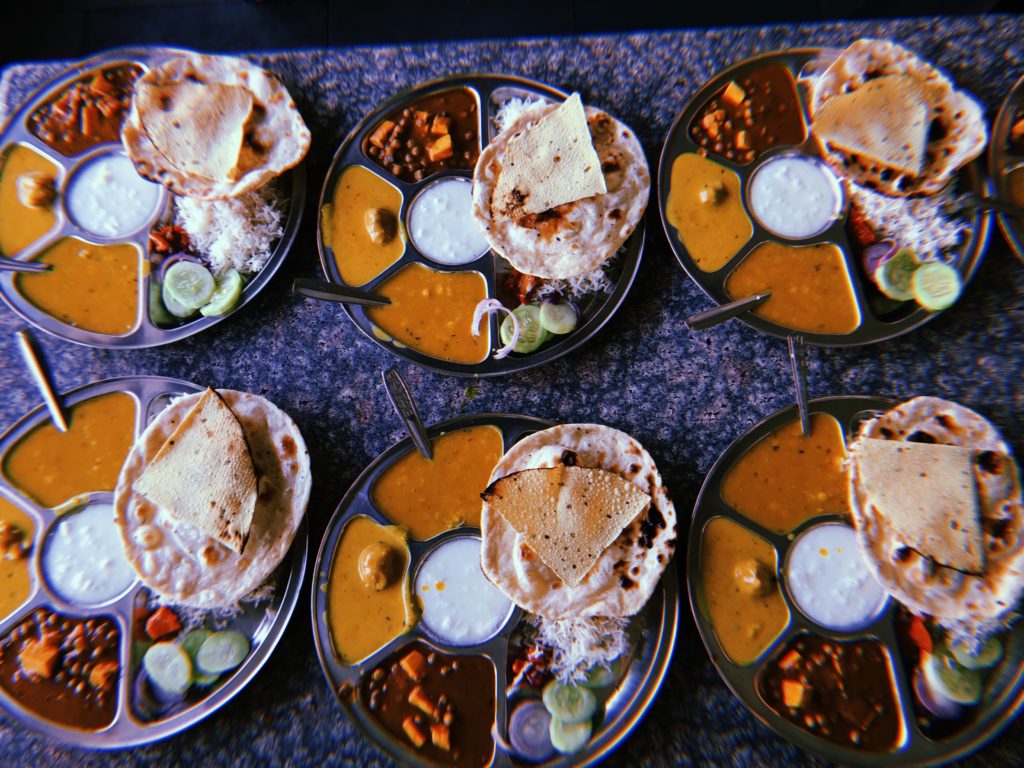
Daily Schedule
Here is what our day looked like during the yoga teacher training course at AYM:
- 6.30am wake up and complete cleansing kriyas (jala & sutra neti)
- 7am-8am meditation or pranayama
- 8am-8.30am chai break
- 8.30am-10am hatha or ashtanga class
- 10am-11am breakfast
- 11am-12.30pm teaching methodology
- 12.30pm-2.30pm lunch
- 2.30pm-3.30pm philisophy
- 3.30pm-4.30pm anatomy
- 5pm- 6.30pm hatha or ashtanga
- 6.30pm dinner
- 7.30pm-8.30pm mantra
The only cleansing kriyas we did were the jala neti, where you run water through your nose with a neti pot and sutra neti where you put a string through your nose and out your mouth. The more advanced kriyas where you vomit and empty your digestive system we didn’t do in the 200 hour program.
Mantra classes were only 3 times per week so most nights you would be free after your last asana class.
Review of my Teachers during the AYM yoga teacher training course
Your teachers are the most important thing when it comes to what you get out of your 200 hour yoga teacher training course at AYM. These are the people responsible for sharing their knowledge and experience and will help shape you into an amazing teacher and yogi!
I’m happy to say I loved my teachers at AYM. They were very experienced and knowledgable and I learnt so much from each of them. The course material and classes were presented in an authentic way, which you would expect from a school in a country that is the source of yoga! Each teacher would start and end every class with chanting om three times!
Note that the teachers may have changed since I attended however this will give you an idea of the level of quality of teachers that AYM has. You can email AYM to inquire who will be teaching when you are looking to attend.
Asana teachers
Ashtanga
Our ashtanga teacher, Awdhesh, was hardcore! It was 35-38 degrees and humid as hell when I attended the AYM yoga teacher training and Awdhesh would always turn off the fans, aircon and close all the windows. In the strict ashtanga rules, he also wouldn’t let anyone drink water during class. This is to build your inner fire which ashtanga is all about! I have never, ever in my life sweated so much.
It was f**king hard but I always felt so good afterwards and got addicted! I even continued to practice every day with Awdhesh for 3 months after my course finished which is a testament to him as a teacher. We completed the primary series of ashtanga over the course of the month. We also did plenty of drills as well as took turns practising leading the classes.
Awdhesh would push us beyond our limits every single day and he always gave the most amazing adjustments! My physical strength and flexibility improved dramatically over the course thanks to him!
Hatha
Our Hatha teacher was the incredible Jaya. He is an AMAZING teacher, I learnt so much from him seriously. Each class we had with Jaya was more workshop style where we would go over a few poses each class in extreme detail. Jaya is trained as an Iyengar teacher so he teaches with perfect precision with focus on alignment and the use of props.
I can’t speak highly enough of the quality of teaching that Jaya gave to us. He taught me so much about specific details of poses, alignment cues and how you should demonstrate and instruct students. His classes were much more about developing yourself as a teacher.
Philosophy, teaching methodology & anatomy
Our philosophy teacher Gaurav is an absolute genius! Gaurav has studied philosophy & psychology extensively and even has a doctorate in psychology. He always presented the theory in an easy to understand way with lots of stories to enhance our understanding. Gaurav also answered every question brilliantly, he seriously knows everything! I learnt so much from him.
Teaching methodolgy was taught by Gaurav’s brother Arpit who was also a very good teacher going over all the steps of how to hold a yoga class. This information was very valuabe and so useful for learning to become a teacher. His approach was light hearted and humerous and it was always a joy to be in his class.
This class was where the main teaching exam took place. For the first half of the course, Arpit taught us the content and the remaining half of the course in this class would be students leading their own 30-minute yoga class with the rest of the group. In the end, he would give us feedback and would get feedback from the other students.
Our anatomy teacher was also the Ayurvedic doctor on-site at AYM. To be honest this was my least favourite class because it was all science-based which was a bit boring but also very important when you’re learning to become a yoga teacher. He had in-depth knowledge of the body and its functions and also taught us about anatomy and health from an Ayurvedic perspective.
Meditation and Pranayama
The first half of the course we would have meditation class in the morning and the second half we had pranayama. Our meditation teacher, Swami Armana, taught us a number of dynamic Osho meditations.
I really loved learning these meditations, which were different then I was expecting! Swami had such a big heart and joyful energy and his class raised everyone’s vibrations so high every morning. The meditations were always filled with music and dancing at the end and included kundalini meditation, chakra meditation, om meditation and more.
We took pranayama classes early in the morning for the last half of the course. Personally, I love pranayama so I attended every class. We learnt all the basic types of pranayama like nadi shodhana, kapal bhati (breath of fire), humming bee breath, yogic breath and more.
The correct counts for breathing, breath retention and exhalation as well as how to advance your practice were taught. We also learnt about the three bandhas and other cleansing kriyas like candle gazing and nauli kriya.
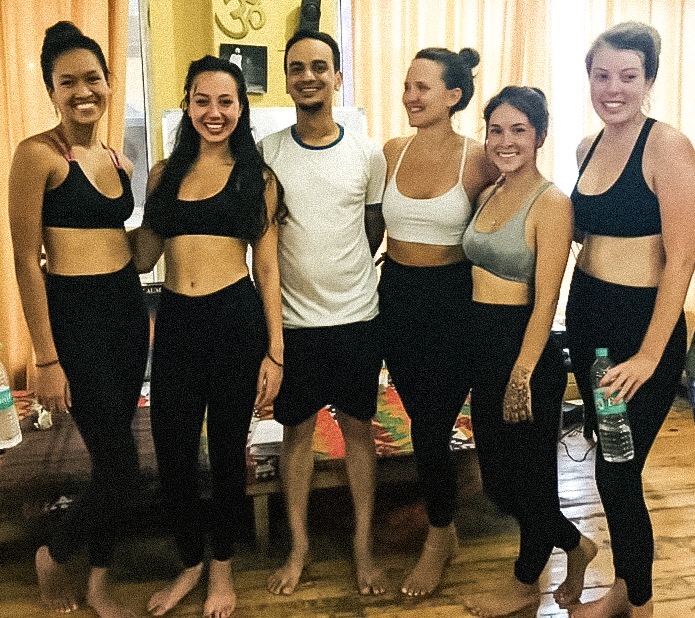
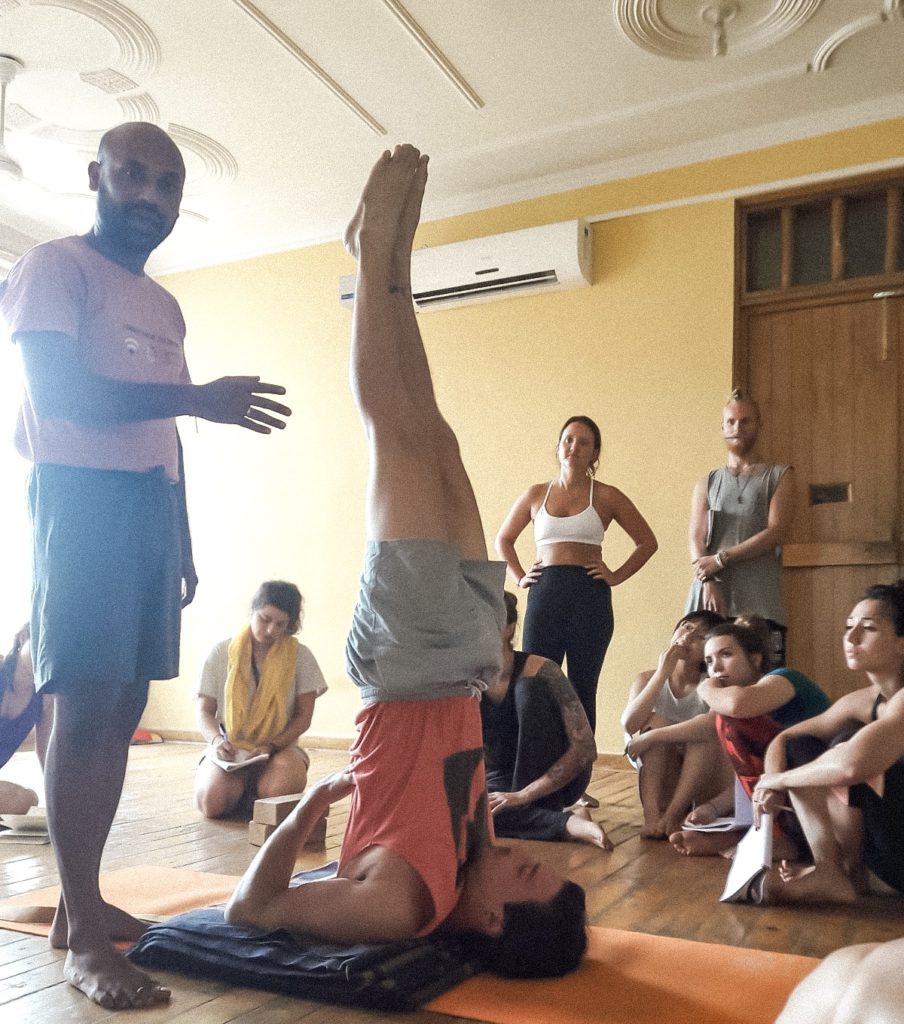
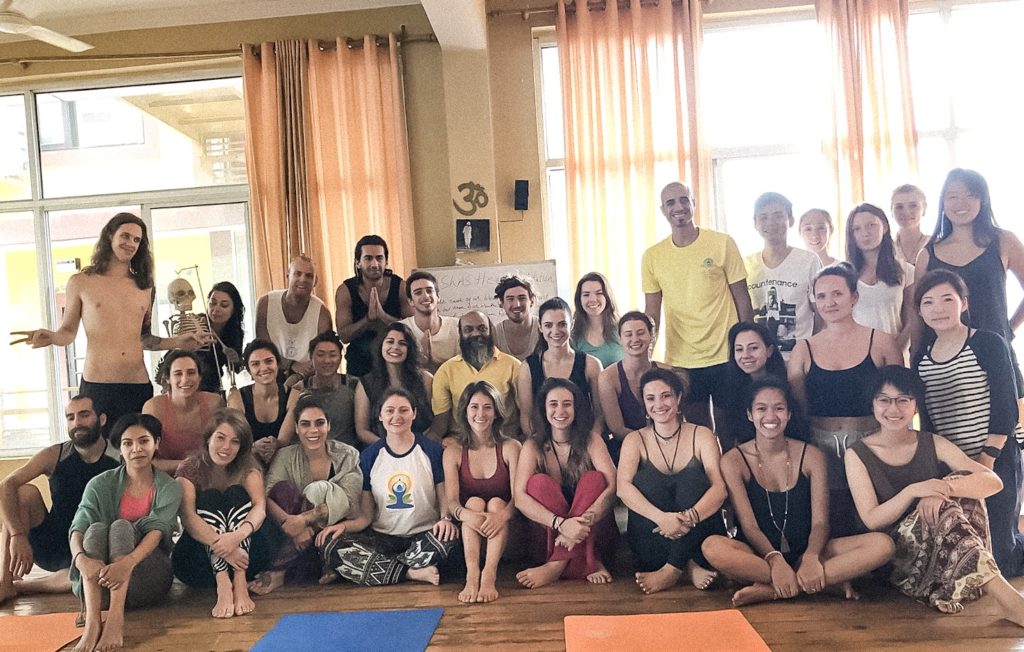
Quality of curriculum & Exams
The curriculum covered during the teacher training course all of the basics and is standard for most of the schools in Rishikesh. The knowledge and experience of our teachers added to the quality of the content we learnt as I discussed above.
The content of what we were taught is very traditional and authentic to the roots of yoga.
This may be less palatable if you only have experience of a westernised version of yoga and you may find the teachings not as applicable to the typical studios you have at home which have power yoga, vinyasa, rocket, hot yoga and so on.
If you are wanting to learn these styles of yoga to teach at home Rishikesh probably isn’t the place to come and do your yoga teacher training course. That being said I think it is really important as a teacher to have a solid base understanding of the roots of yoga so if you aren’t sure which kind of yoga you want to teach coming to AYM to do your first yoga teacher training is a really good place to start. From there you can find your voice and your style and do more specialised training later in your yoga teaching career!
Our exam for ashtanga required us to write out the primary series of ashtanga with Sanskrit names. For teaching methodology, we had to lead one 30 minute class by ourselves. We also had a test for anatomy and philosophy where we had to answer a few questions. We never received any marks or feedback from our written exams which was a shame!
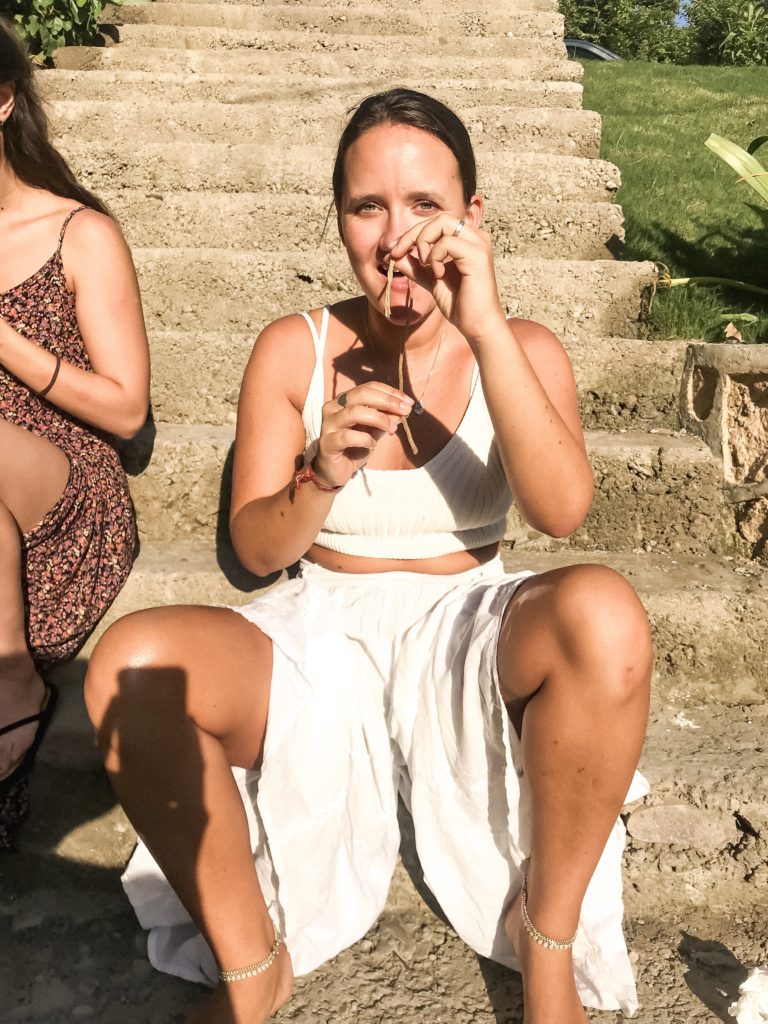
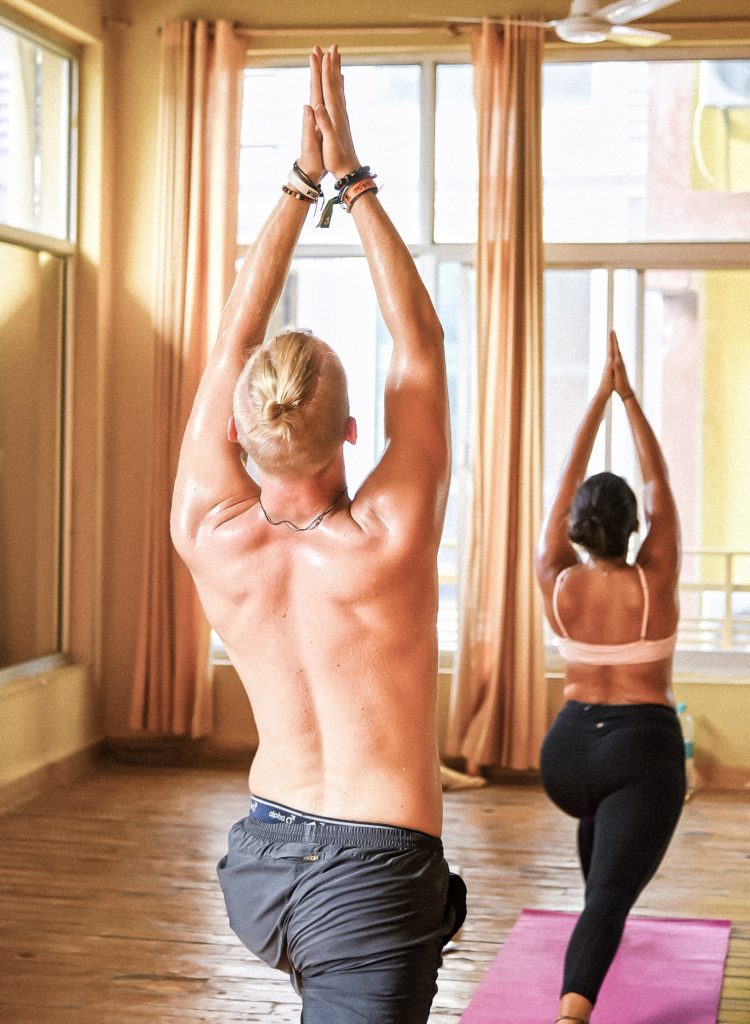
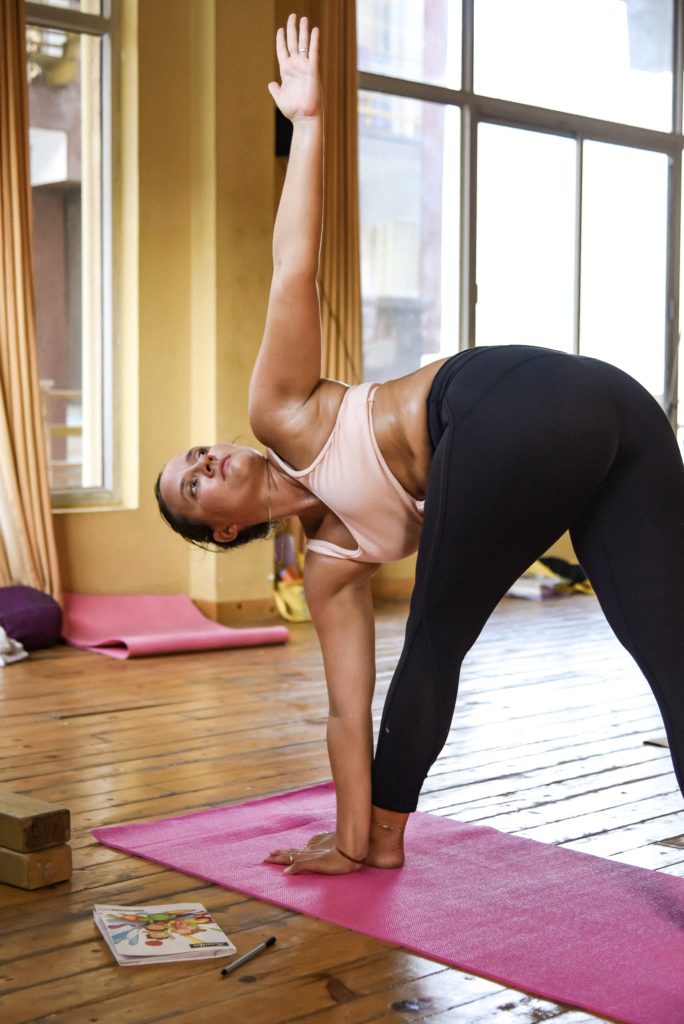
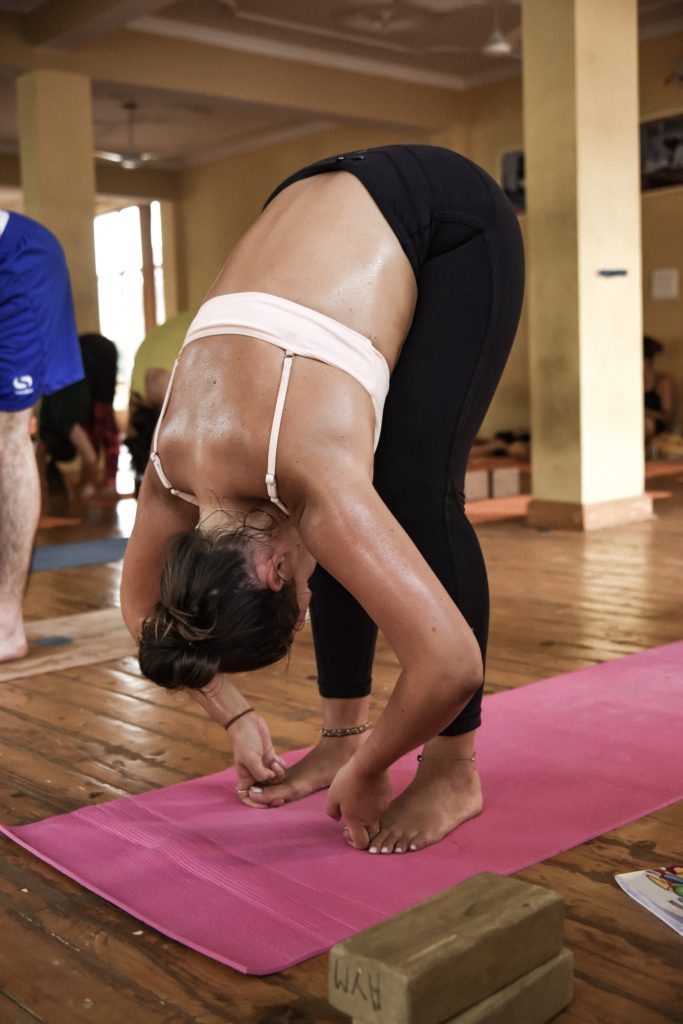
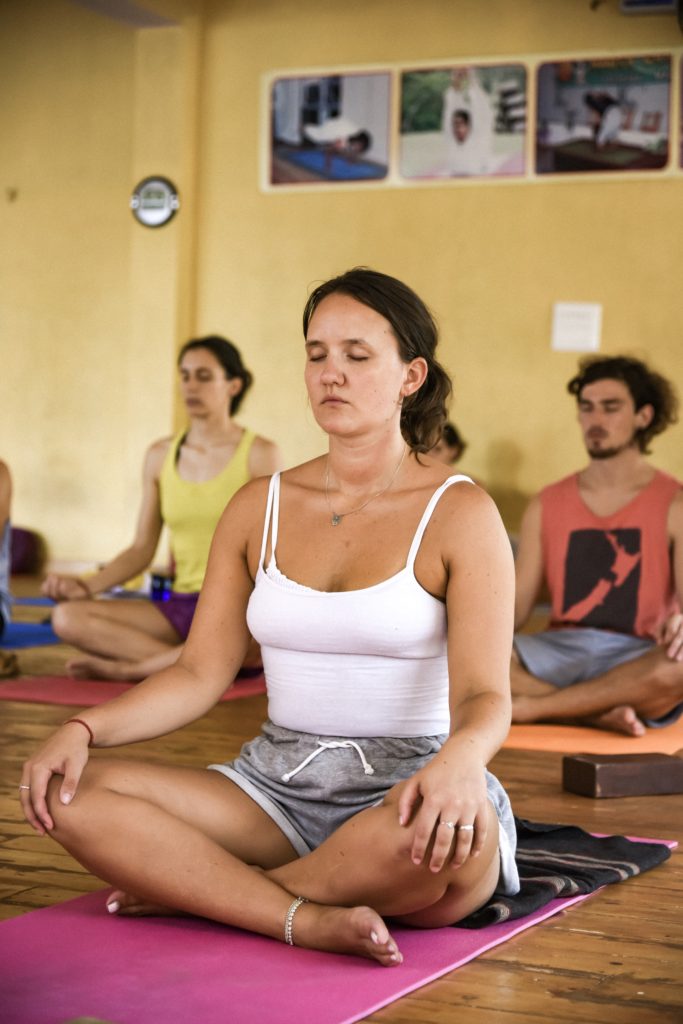
My fellow students at AYM
This was the best part about studying at AYM! My group was around 40 people from all around the world. There was a mix of friends, solo travellers and couples. I think I hit the jackpot with my group, everyone was super cool and got along so well. There was also a lot of men in the group which was nice to balance out the energies. I was worried it would be just all women!
Life long friends were made from my group at AYM and my fondest memories are the times spent laughing and hanging out in the school and in Rishikesh.
I even took the plunge and got my first tattoo on the last day of our course with the strong encouragement of my new mates, I now have 14 tattoos!!
It was surprising when I arrived and learned that there were 40 people in the group as they say classes do not exceed 20 people. They get around this by splitting the asana classes into two groups, one group does Hatha in the morning and ashtanga in the evening and the other does the opposite. However, all the other lectures and classes were combined with 40 people which definitely did make it less intimate and a bit more distracting but it wasn’t much of an issue.
Having this many people meant there was such a mixture of personalities that there were friends for everyone and there was never a dull moment.
I think it is also worth noting that most of the people who come to study yoga in Rishikesh do it to deepen their own practice, not necessarily with the intention of becoming yoga teachers when they return home. Some people may have never even done yoga before as there are no prerequisites. This means that a lot of people don’t take the course too seriously and may skip a lot of classes.
This is just something to be aware of if you are wanting to become a yoga teacher and are serious about learning you will need to take the responsibility yourself for what you get out of the course as no one is going to force you to attend classes, practice teaching and study for exams.
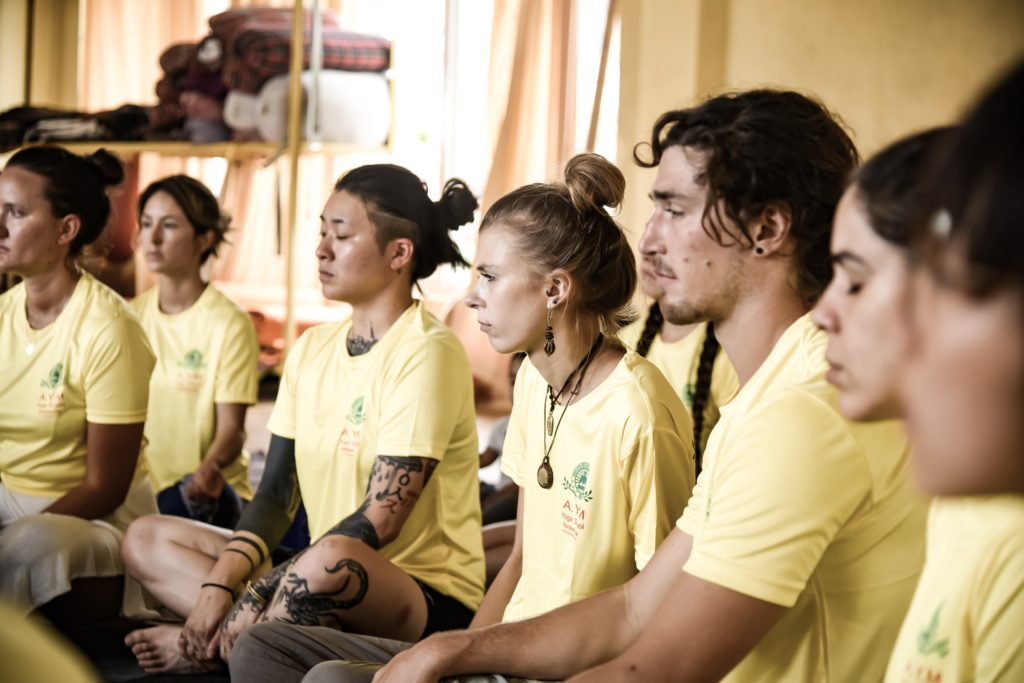
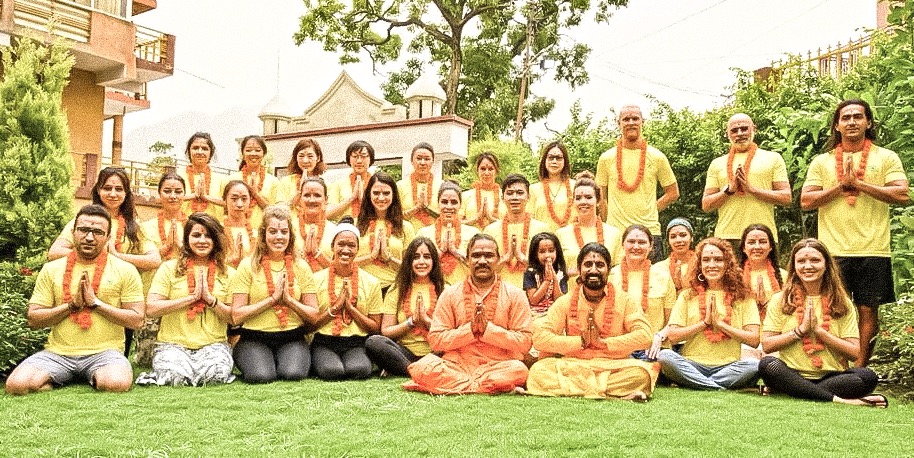
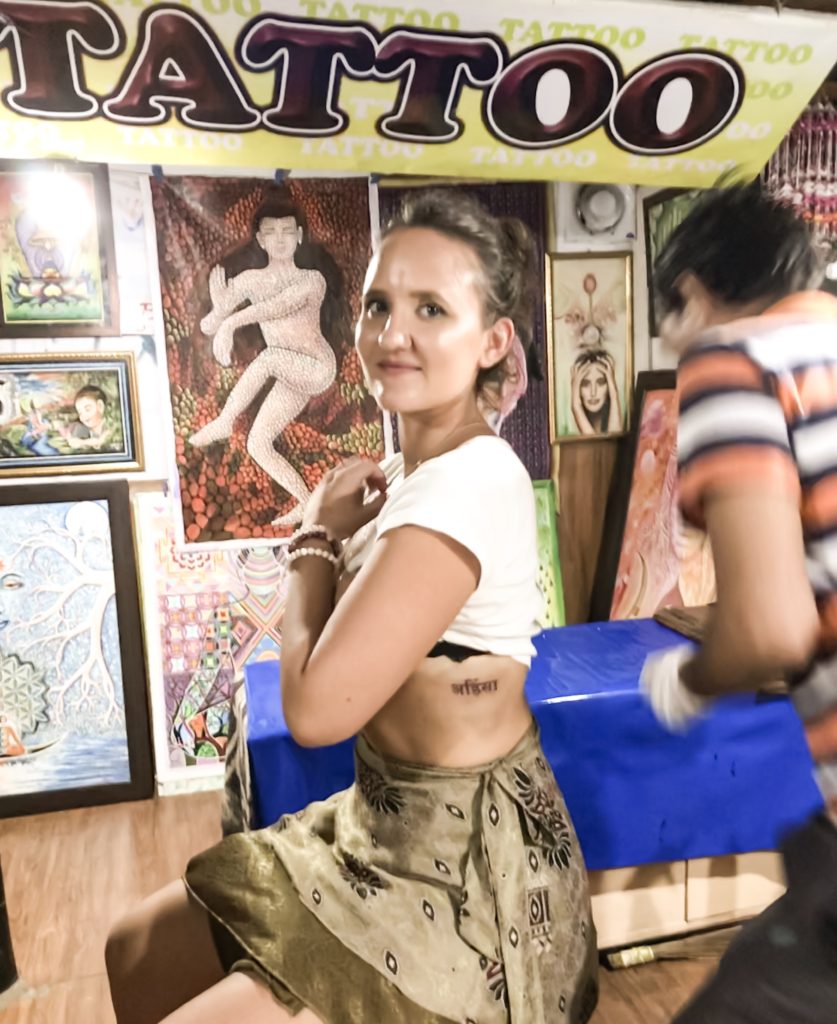
Overall Pros and Cons
Pros
- Nice grounds and beautiful yoga hall
- Excellent teachers
- Amazing group of students
- Tasty food
- The best location in Rishikesh
- A solid curriculum that covers all the essentials to become a teacher
Cons
- A large group of students for the lectures
- They didn’t mark our exams
- Only one organised excursion included (if this is what you’re into!)
- Having to clean our own rooms kinda sucked
- Rules about attendance are not enforced
Would I recommend AYM?
Yes!
Overall I would recommend AYM to complete your 200-hour teacher training in Rishikesh. I was happy with my teachers, my group and what I learned. My expectations were definitely met.
The accommodation isn’t fancy and you do need to do some things for yourself. This is absolutely represented in the price and remember this is India! The food can be intense on your stomach at first but you will adjust and there are plenty of cafes around to get your Western food fix for very cheap.
If you are unhappy with something all you need to do is talk to the owner, Mahesh, and he will make sure your issue is solved. A lot of time people complain about things without actually asking for a resolution.
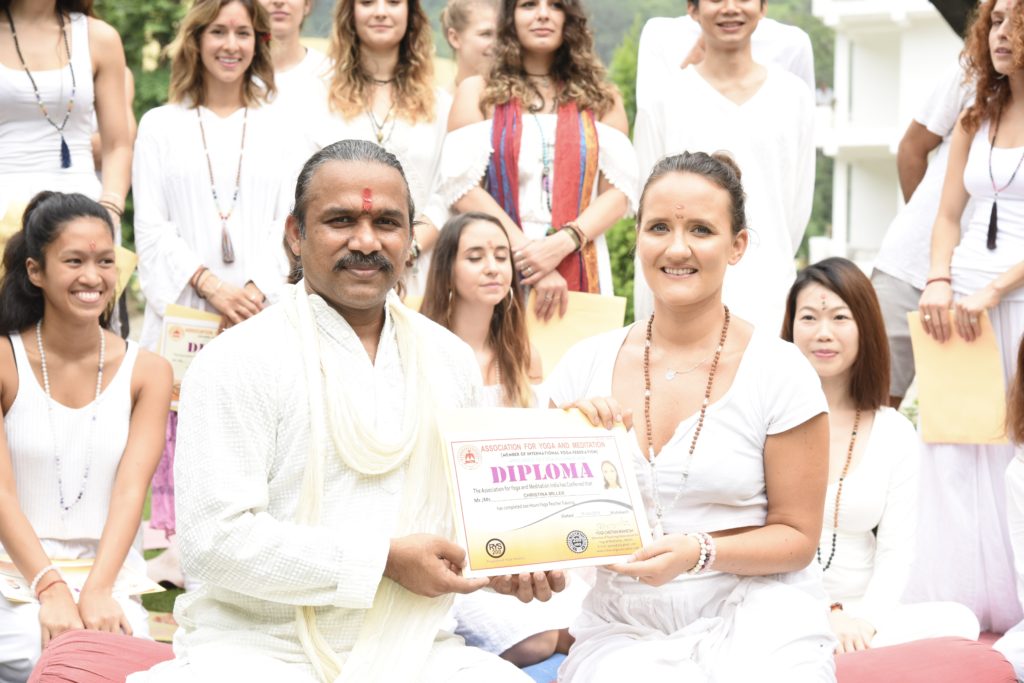
Tips: What you need to know before you arrive
A bit about the standards of the schools in Rishikesh.
As a general rule in life, you get what you pay for and choosing to attend a yoga school in Rishikesh is no exception. Like I have mentioned above the accommodation isn’t five star and you need to make sure you have your own towels, toilet paper and you need to do your own cleaning and laundry. Every school in Rishikesh has similar standards when it comes to the lack of Western luxuries. As long as you go without expectations of something fancy you will be very happy with what you get.
The teachers in Rishikesh are mostly Indian and have gone through extensive training to be able to land prestigious jobs here. A majority of the fee goes towards the teachers. For the price, you get access to amazing knowledge and resources.
About Rishikesh
If Rishikesh is the first place you visit in India be prepared for a culture shock! It feels like a chaotic circus when you first arrive. The streets are packed with cows, beeping scooters, monkeys and a ton of Indian and Western tourists. The streets are hectic and there are no footpaths anywhere. You need to spend some time here to get used to it and to tune in to the magical energy the city holds.
There are 4 main parts to Rishikesh. The first is Rishikesh Market, which is actual Rishikesh. This isn’t where any of the tourism is and is purely local. You probably won’t spend too much time here unless you want to visit some different markets and get some more authentic, cheap Indian eats.
The next is Tapovan, where AYM is located. This is part of the touristic area in Rishikesh and in recent years is developing more and more like the hub for yoga schools. The main road is connected to Tapovan.
The next is Laxman Jhula, which is across the bridge from Tapovan. Laxman Jhula is disconnected from Tapovan by a bridge. Only pedestrians and scooters can cross the bridge. Here you will find many clothes and souvenir shops and cafes all along the bank of the Ganges. This is the best place to chill, shop and hang out in cafes. There are many hostels and guest houses in this area. It is the most expensive part of Rishikesh. This area is more catered towards Westerners.
Lastly, there is Ram Jhula. Ram Jhula is between Laxman Jhula and Rishikesh market. This area is more geared towards Indian tourists and ashrams. It is cheaper and more hectic with more street food and plenty of babas and sadhus. This is where the famous Parmath Niketan ashram is that holds Ganga Aarti every night.
Withdrawing cash in Rishikesh
Withdrawing money is notoriously difficult in Rishikesh. There are only a couple of ATMs in Tapovan that work for international cards. This means they are often out of cash and sometimes not working at all. You may need to get a tuk tuk into Rishikesh market where there are plenty of ATMs or get a cash advance from one of the tourist shops in the market.
ATMs usually limit each withdrawal to 10,000 rupees ($140).
How to pay for your course
AYM requires a deposit of $200 with the remainder due on arrival. Carrying that much cash with me wasn’t an option as I was travelling beforehand in Europe. I thought I would be able to just get cash out from the ATMs but I was dreaming!
I ended up paying via Transferwise. It’s great that AYM lets you pay via Transferwise! The fees are low and I didn’t have to worry about ATMs or carrying heaps of cash with me. A lot of people just paid in cash in either USD or GBP but this isn’t safe to carry on you if you are travelling beforehand. This is a good option if you are coming straight to Rishikesh from your home country.
Get prepaid travel card
Get a prepaid travel card before you go and save money on exchange rate and ATM fees. If you are in the UK, Europe or Australia I recommend Revolut. You can open an app-based account in minutes. Hold and exchange 29 different currencies and spend anywhere with no fees in over 150 countries with a contactless MasterCard or Visa. I have used their online account and prepaid MasterCard for over three years and I love it. I have saved a fortune on fees.
You get £200 of free ATM withdrawals a month (only 2% after that) and the exchange rate they give is the market rate
You also will get individual GBP and EUR IBANs auto-savings, cutting edge budgeting and analytics, which is so useful I even use Revolut for all my transactions at home when I am not travelling.
There is also a Premium plan which offers exclusive card designs, overseas medical insurance, £400 free monthly ATM and unlimited FX transfers.
Revolut has a 24/7 live chat in the app so if you have any issues someone is there to help you with your questions.
Packing tips
One of the great things about Rishikesh is that almost everything that you can get at home is available here thanks to the organic stores. In saying that here are a few things you may want to bring with you.
Plenty of yoga pants from home. You will be using these a lot and sweating a ton if you are going in summer. Buying quality yoga pants in Rishikesh is hard and expensive so bring enough.
Tampons and/or a menstrual cup. The options of tampons are limited in Rishikesh and they aren’t cheap so bring what you need from home.
A yoga mat. You will most likely want to use your own yoga mat as the mats available at the school aren’t very good. The options of mats to buy in Rishikesh isn’t great as they’re all pretty cheap and will wear out fast. So if you like to practice on a good mat bring it with you!
Earplugs! The street dogs love to bark all night long which can definitely keep you awake. Not something you want when you have a full-on schedule of yoga and lectures 6 days a week so make sure you bring some earplugs.
The dress code is white for the closing ceremony so pack some white things. Otherwise, you can buy nice white stuff for really cheap once you are there.
Healthy snacks and natural toiletries are readily available in Rishikesh thanks to all the Ayurvedic products in the country so I wouldn’t worry too much about not having access to these items in Rishikesh.
The best time to visit Rishikesh for a yoga teacher training course.
The best months to come to Rishikesh for a yoga teacher training course are from September to October and March to April. These are the months where the weather is the most comfortable to practice in. It is also when all the top teachers are in town and all schools will have their courses available. If it works for your schedule then definitely choose those months to come.
April to June the weather is dry but extremely hot which may not be suitable when you are doing such strenuous training.
From around the end of June to mid-September is when the monsoon comes. This is a very challenging time to be in Rishikesh, it is hot, humid and always raining at some point in the day. Your clothes never dry and mould gets in everything, plus there is no real drainage system so you are constantly walking through rivers! This is also the most popular time of year for Indians to come to Rishikesh for a pilgrimage to the Ganges so it can be extremely hectic and overwhelming.
In the months of November to February, it gets quite cold in Rishikesh especially at night time and in the morning. The weather during the day is usually beautiful and sunny and the Ganga goes bright green, however, the days are short. Pretty much nowhere will have any heating so you have to keep warm with blankets, clothes and bonfires. The cold weather isn’t ideal for practising yoga and meditation in the early hours.
Rishikesh is busy all year round regardless of the weather and most schools have teacher training programs running all year, including AYM, so you definitely can come to Rishikesh anytime but it is definitely good to know what you are in for weatherwise!
Get a SIM
This should be the first thing you do when you arrive in India! You can get a SIM card at arrivals in Delhi airport. For around max 1000 rupees ($14), you can get a SIM and a 90-day package which gives you 1.5gb per day (YES PER DAY) and unlimited calls and texts within India.
This will make your life so much easier and it means you won’t worry about shitty Indian wifi. My SIM card is with Airtel who have the best coverage in North India. It is best to get a SIM from an authorised Airtel store as the guys in the street shops will try and rip you off. You should be able to get a one month package and SIM for 250 from an Airtel store and top up each month for 200 rupees. This will not be an option in the street shops.
Note that if you plan on staying in India longer than 3 months your SIM card will be deactivated after 90 days and you will need to get a new one. This is the rule they have for foreigners.
Download Redbus
Redbus is a bus ticket booking app that you can download onto your phone. You can book buses easily all throughout India and it accepts foreign card. It is so helpful for trip planning and it gives you all the available options. It also saves you going to an agent and they always have discounts and cashback offers going.
You could download this app and book yourself a bus to Rishikesh from Delhi before you even arrive! When you are ready to leave Rishikesh you can book buses to so many places directly from Rishikesh or Haridwar like Rajasthan, Himachel Pradesh & Agra.
Because of the mountains, the bus is preferable in this region, it is also easier to book buses much closer to the date you want to leave than trains which require you to book really far in advance (unless you want really expensive AC tickets).
The buses are also way less intimidating when you first start travelling in India especially if you are alone. If you are a female they will not allow a male to book a seat next to you to help you feel safer. 9/10 you will be the only female on the bus and the only Westerner.
For more of my backpacking tips check out this blog post!
This is the end of my review of the AYM 200 hour Yoga Teacher Training Course in Rishikesh. Thank you so much for taking the time to read this far. I really hope you found some useful insights to help you make your decision!
There you have my review of AYM’s yoga teacher training course in Rishikesh!
If you have any questions about Rishikesh or AYM please leave them in the comments or shoot me an email at chasingcoconuts.co@gmail.com or DM on Instagram at @chasingcoconuts_.
For more information on AYM and to book a place in the school click here!
This post contains an affiliate link for Revolut & Book Yoga Retreats. If you decide to purchase through these links, I receive a percentage of the sale at no additional cost to you.
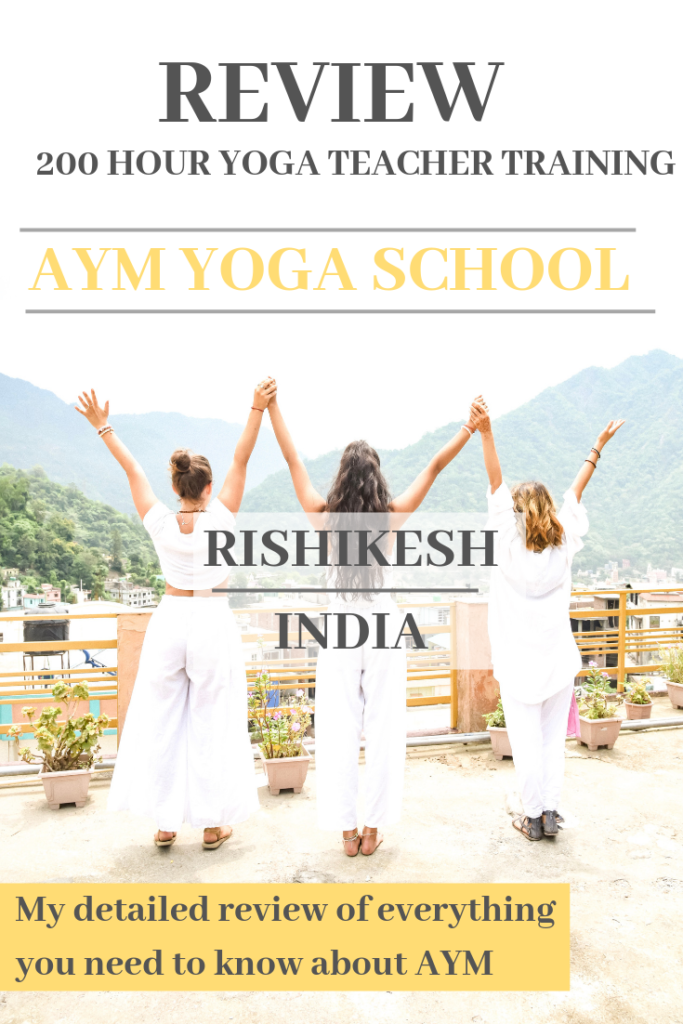
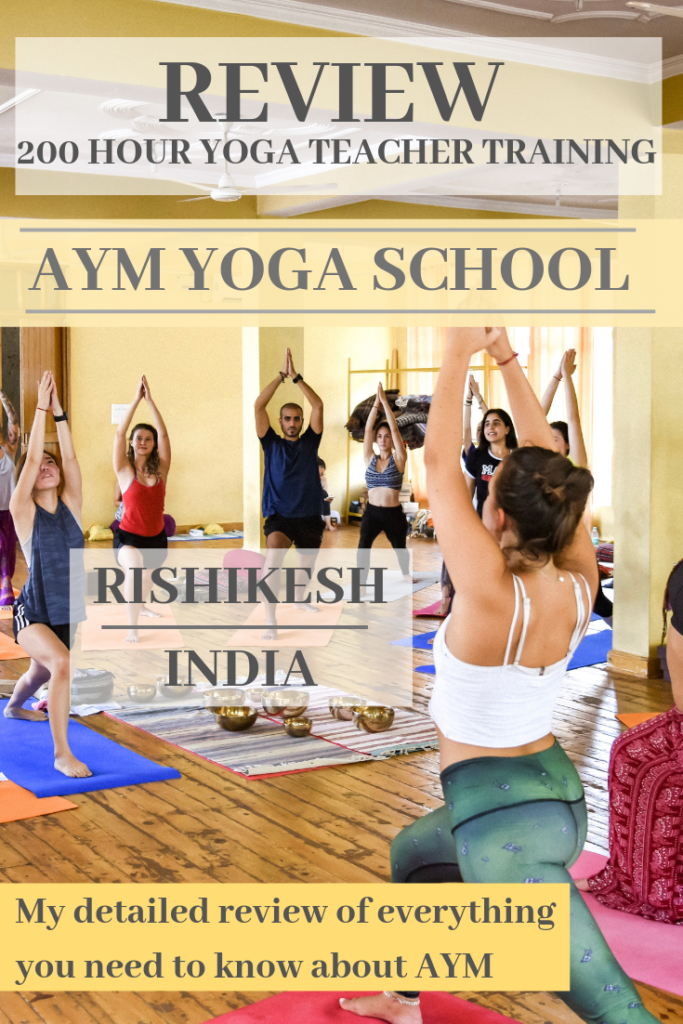
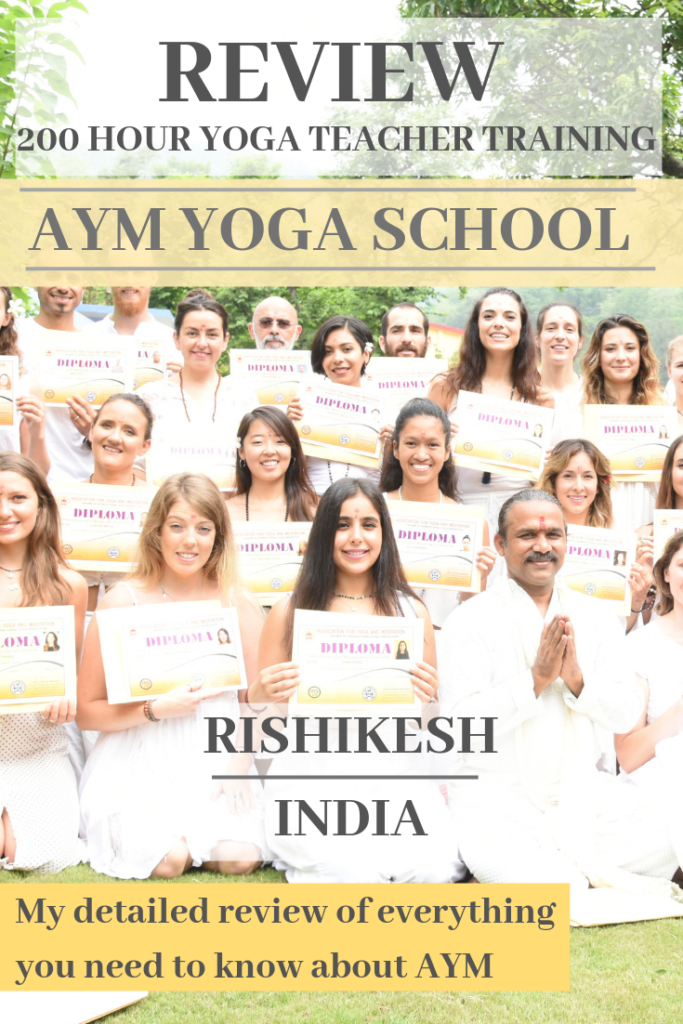
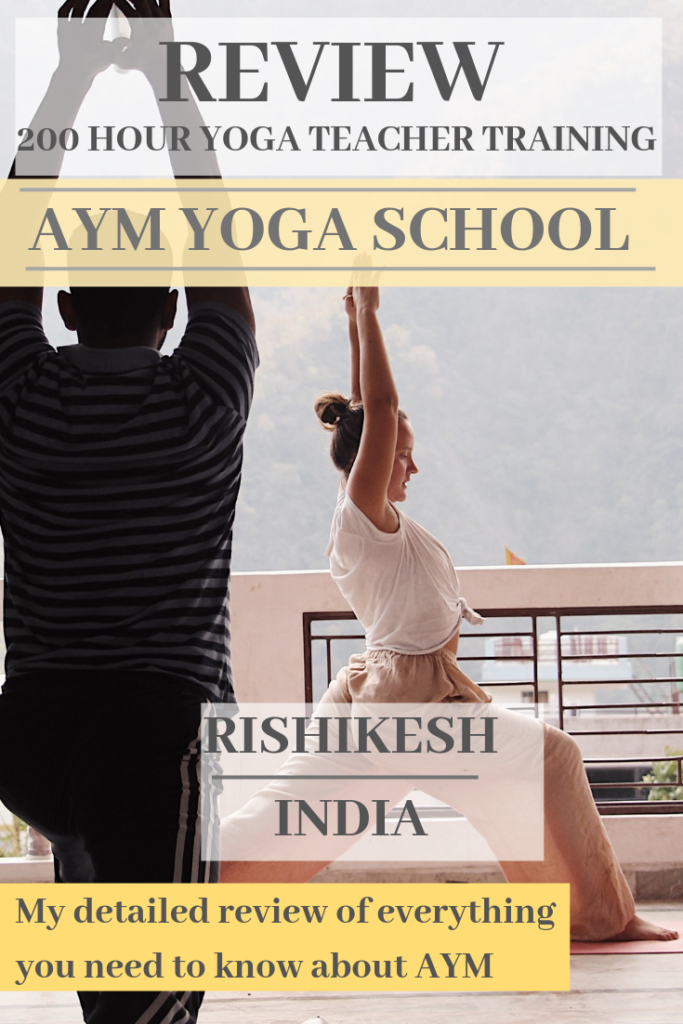

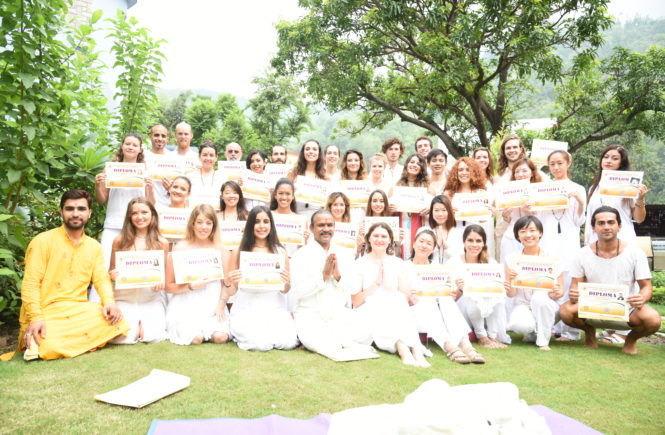
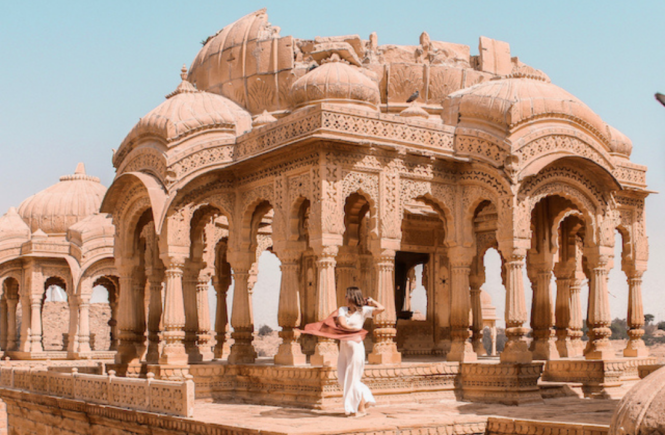
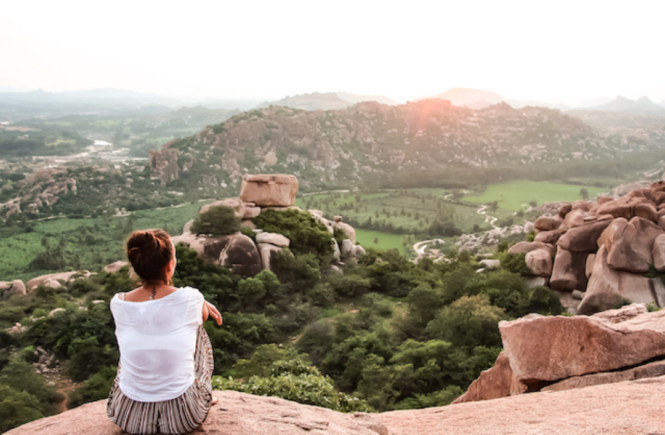
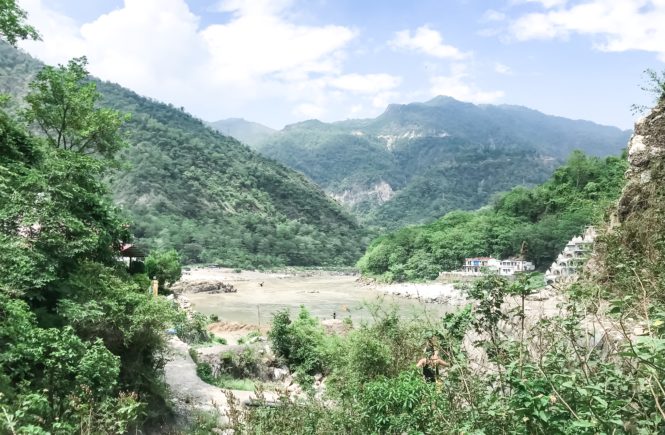
8 Comments
I would definitely join there..It looks so relaxing…
It definitely wasn’t always relaxing!
Christina
Lovely article, I have been to Rishikesh a couple of times, nice to see this dimension of the story, Yoga Training institutes.
Very comprehensive / thorough explanation.
All the best.
James
Thanks James!
Nice Blog, yoga teacher training program in Rishikesh, India typically involves comprehensive instruction in the principles and practices of yoga. Rishikesh is considered a spiritual hub and is often referred to as the “Yoga Capital of the World.” It is located in the foothills of the Himalayas and has a rich tradition of yoga and meditation.
Wow, this was so very informative and you have not forgot one thing! I have read everything inside and out and you have provided very valuable information – incredibly detailed and thorough. THANK YOU from my heart!!! I have been researching non-stop for almost one month, which Ashram to choose in Rishikesh for my next YTT300 for April, 2023 as I am coming from Canada and really want to make sure I have chosen the right one. And, for me, I would probably want to be in a smaller group, more intimate group of people. 🌹
You’re welcome! I went through the same process researching like crazy and it was so hard to decide – so I wanted to write something that covered allllllllll the details! Good luck in finding the perfect school for your 300 hour training 🙂
Nice Post, yoga teacher training program in Rishikesh, India typically involves comprehensive instruction in the principles and practices of yoga.